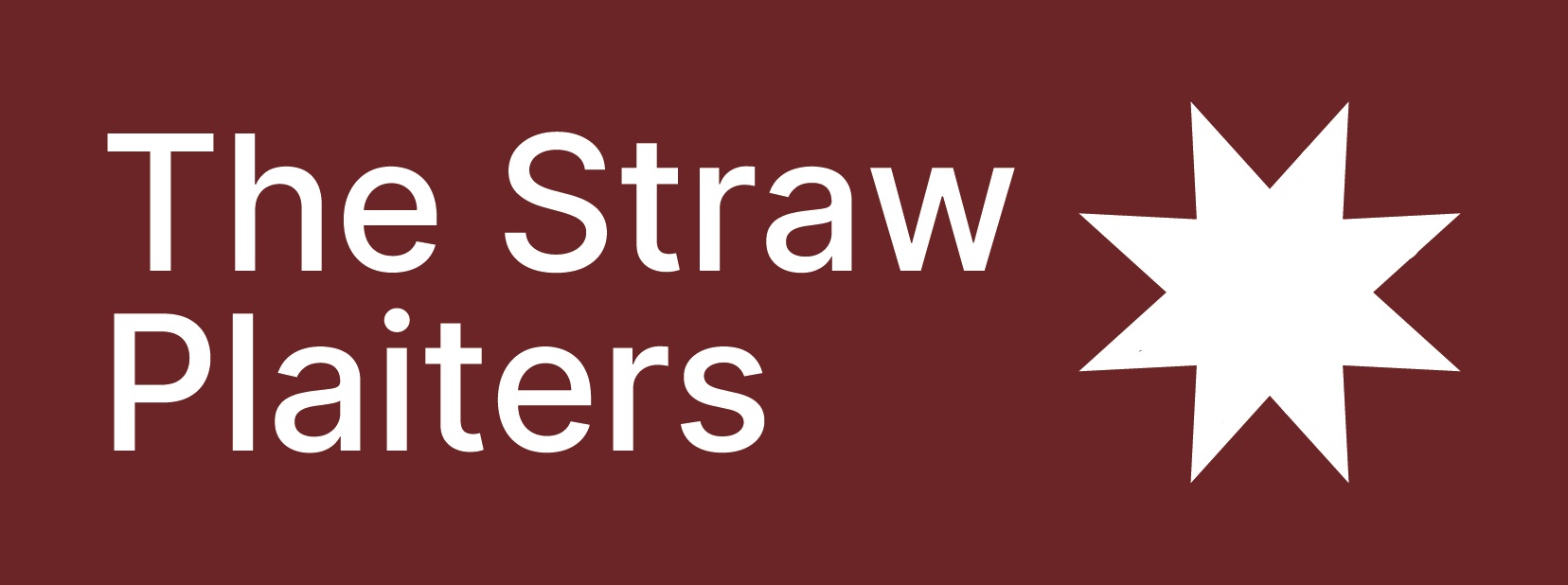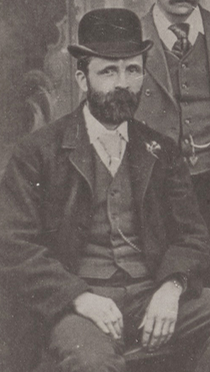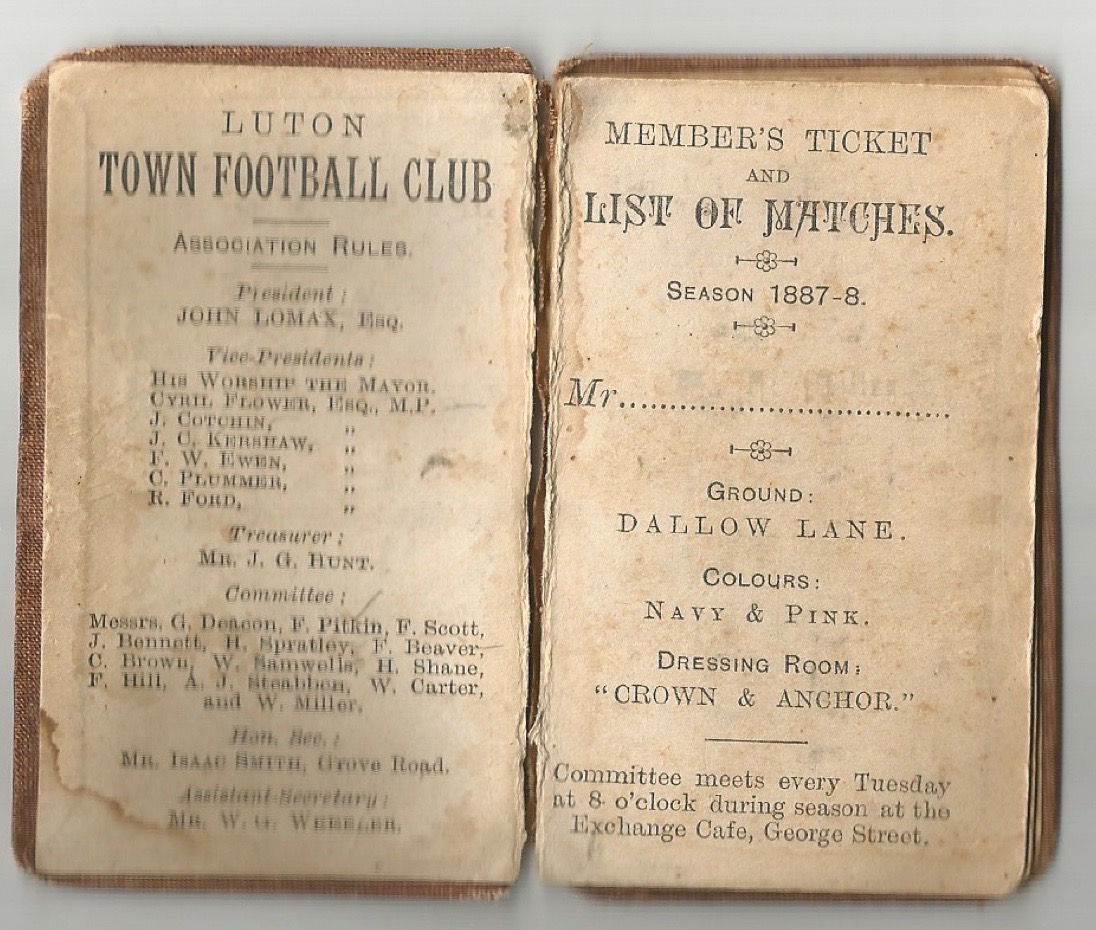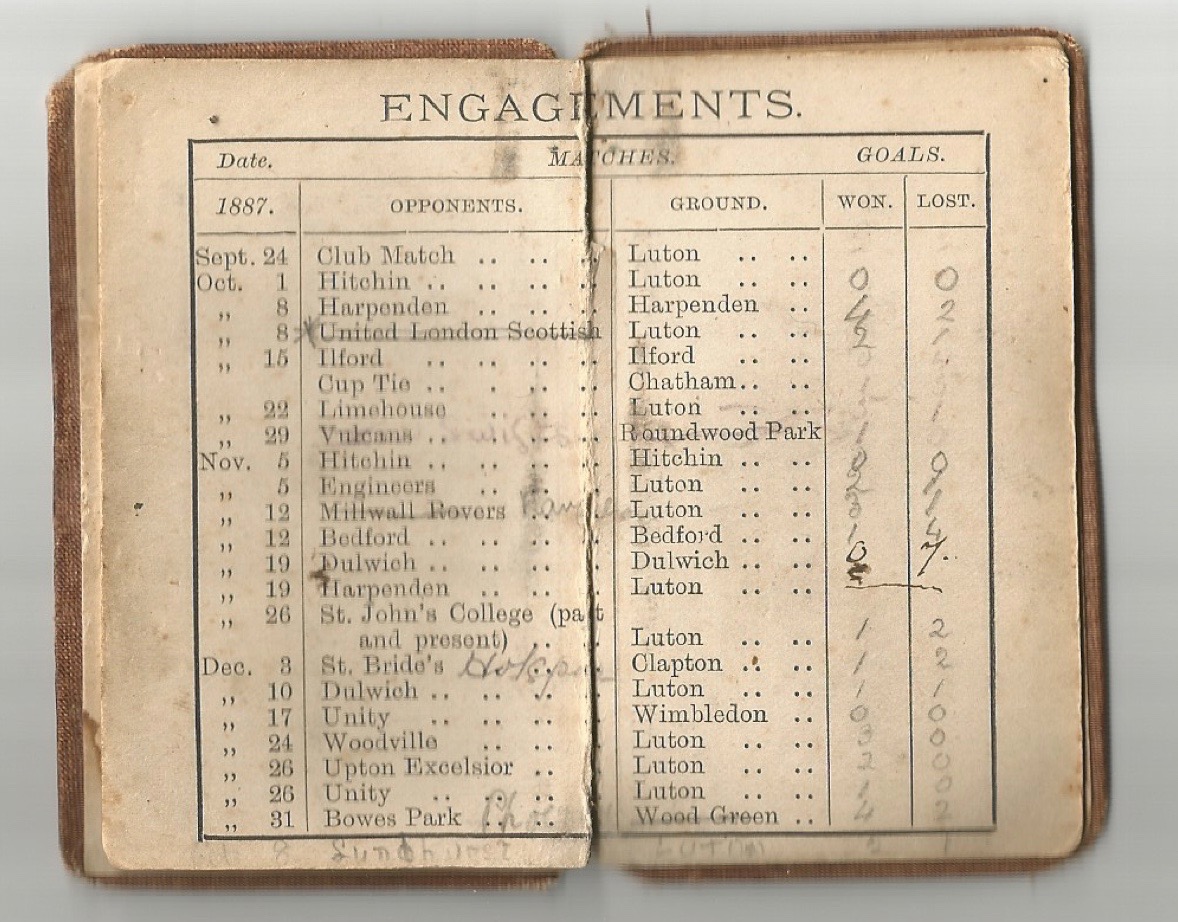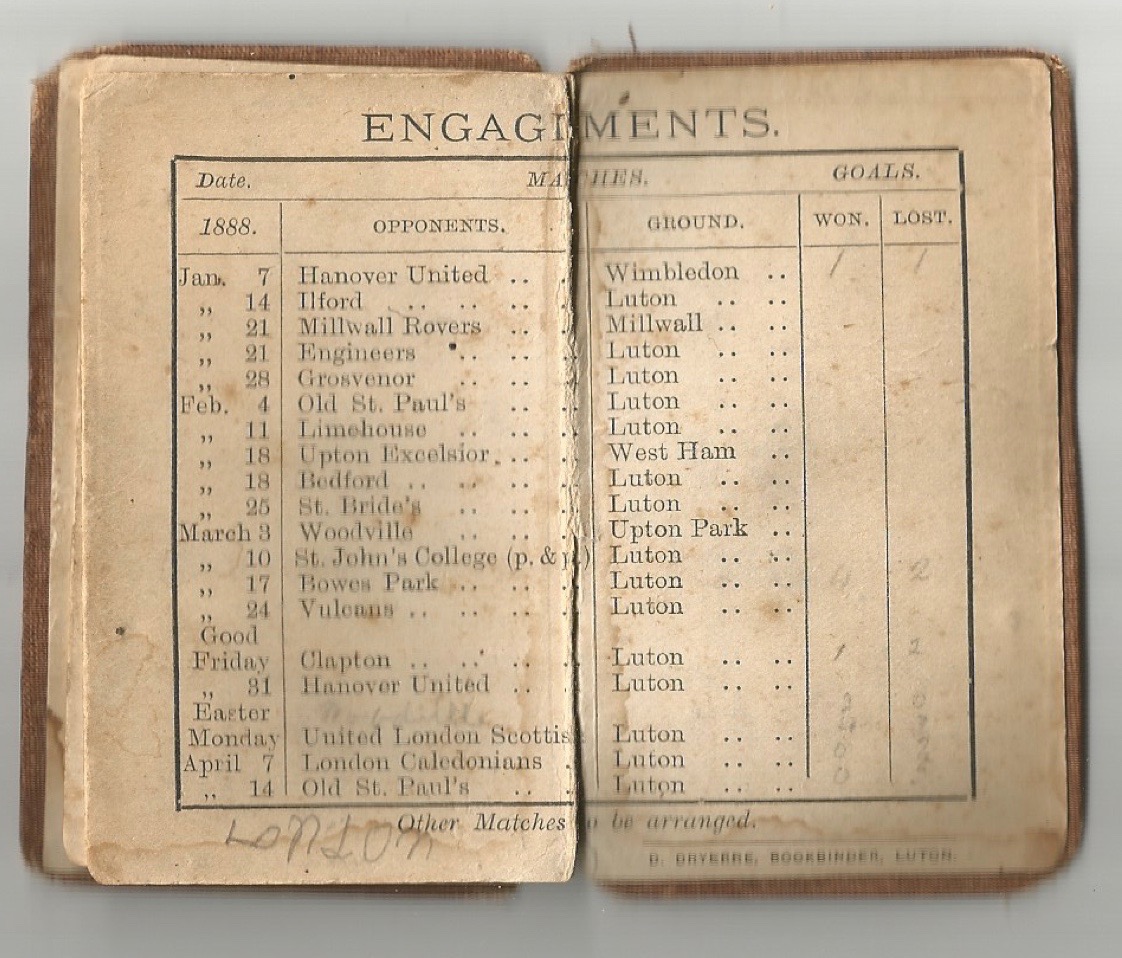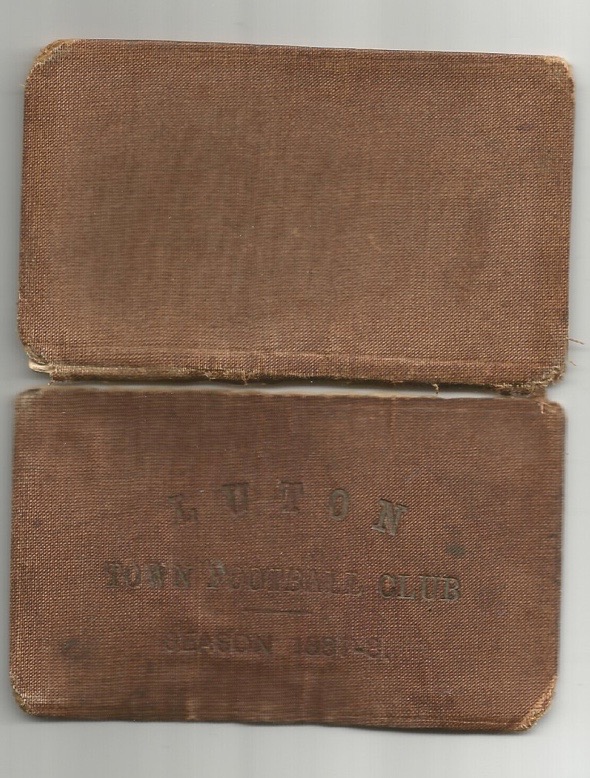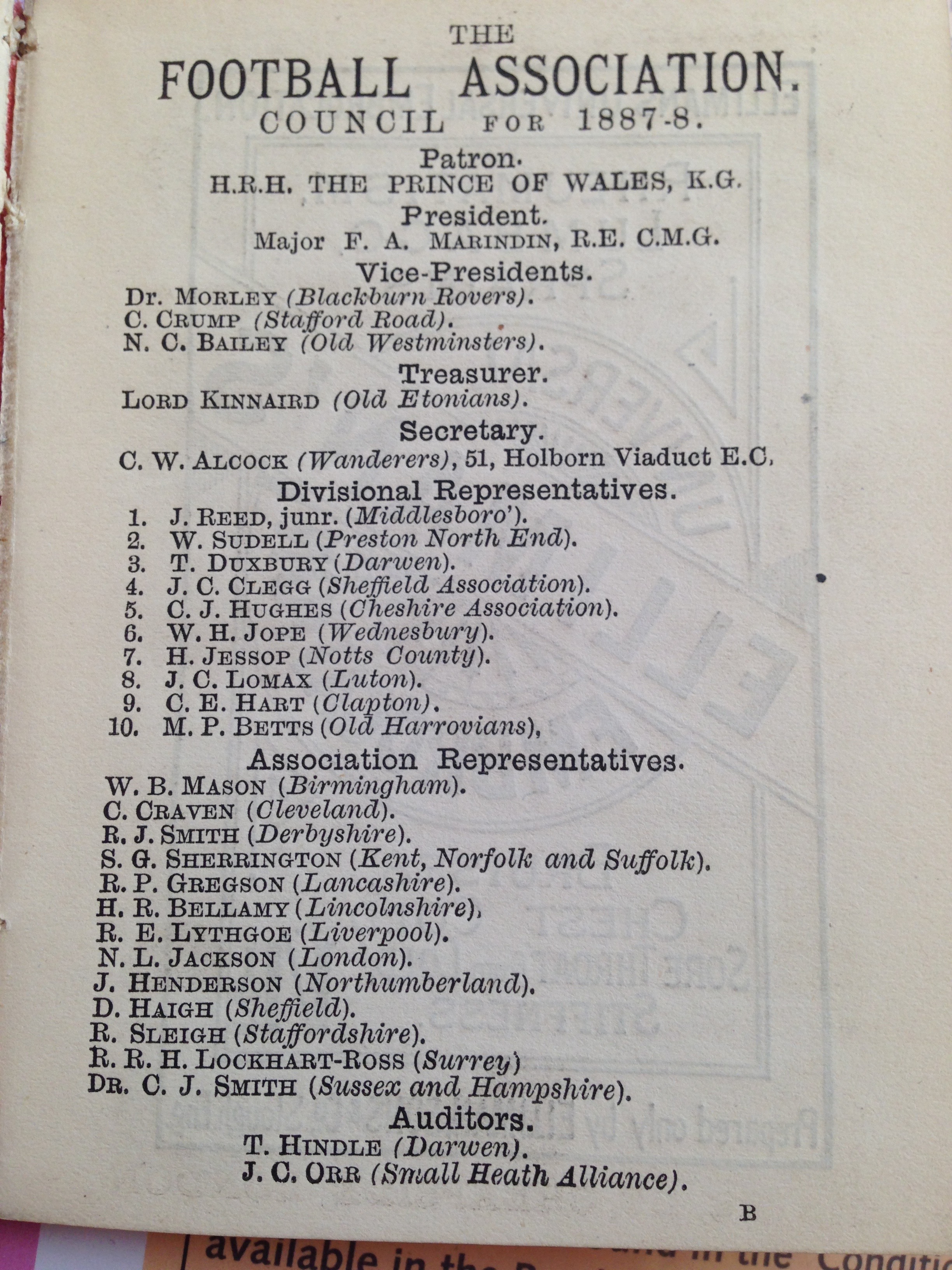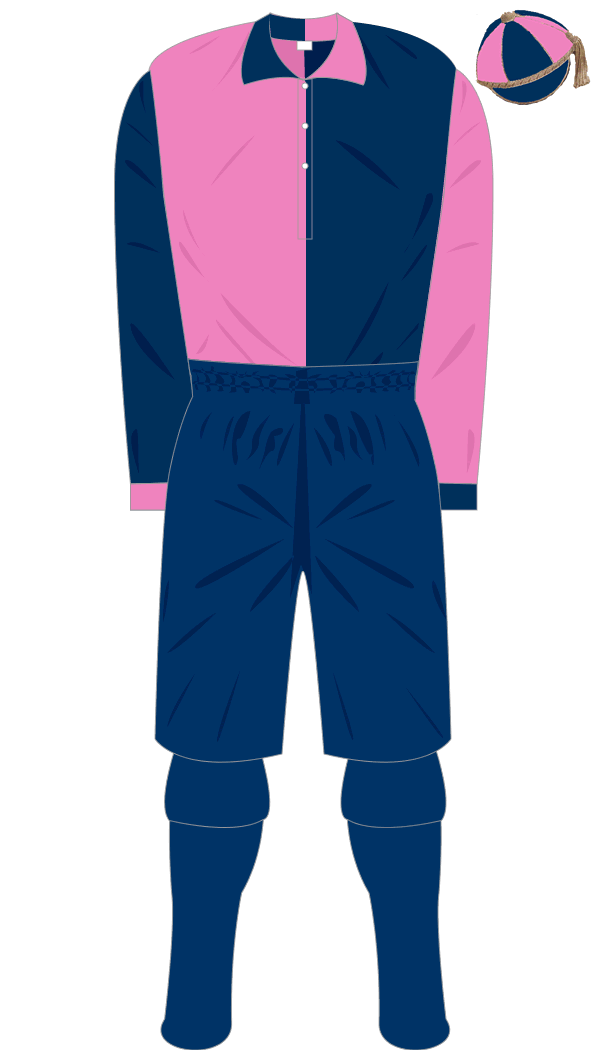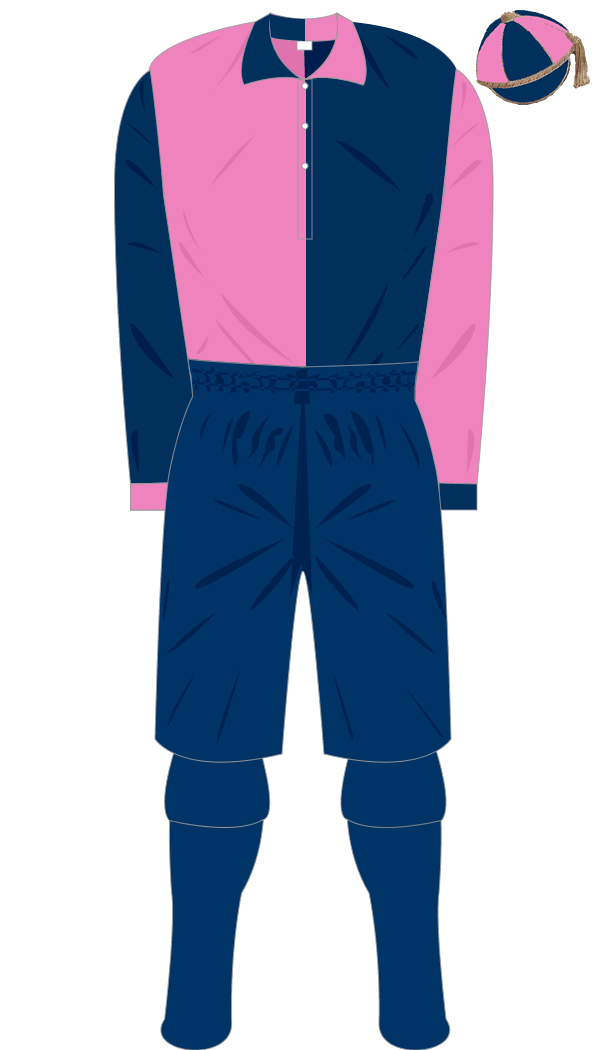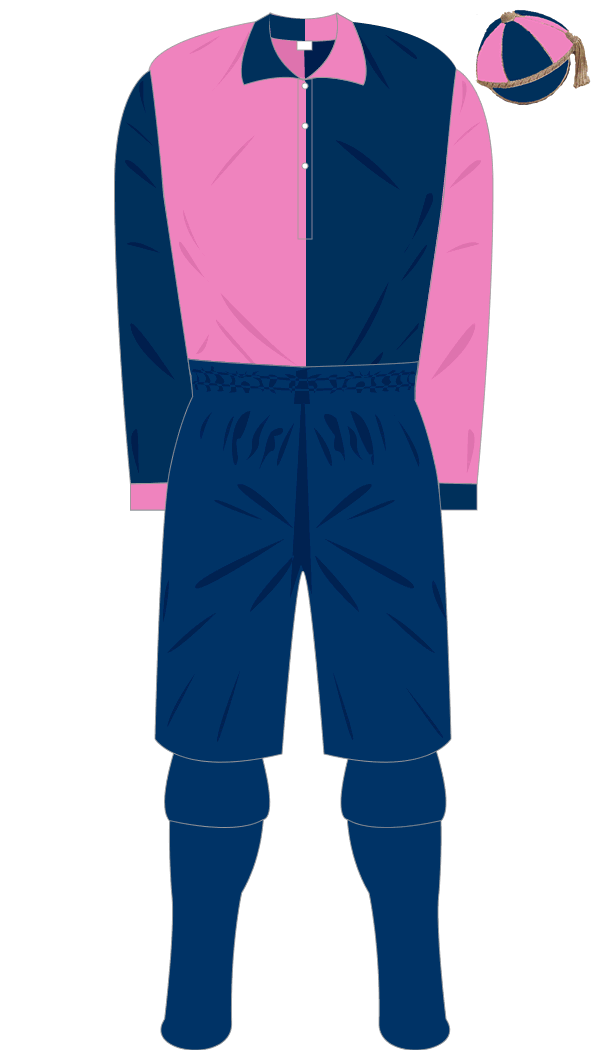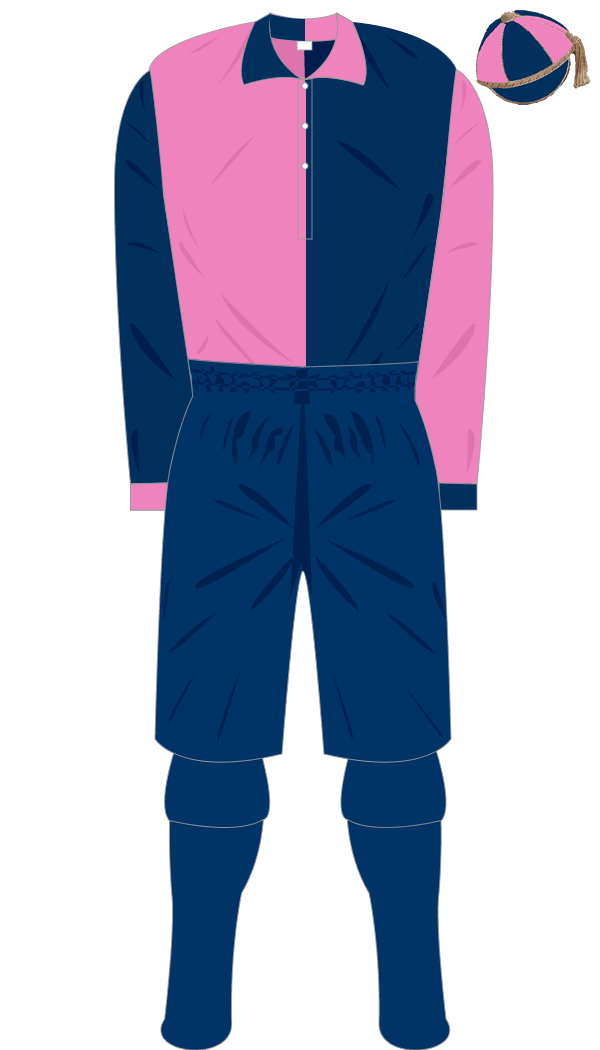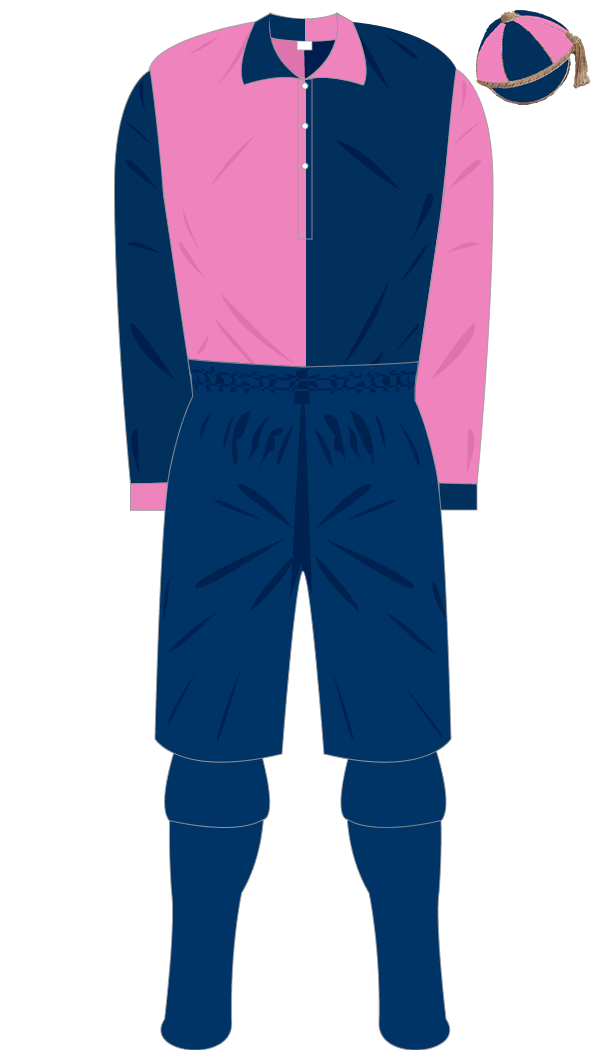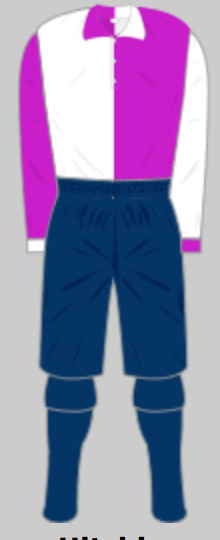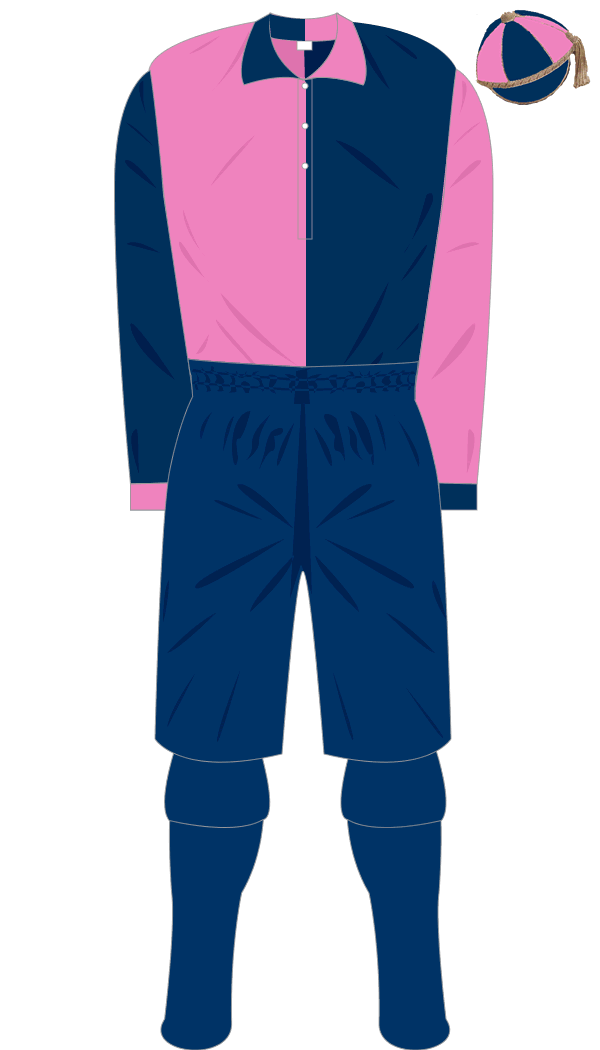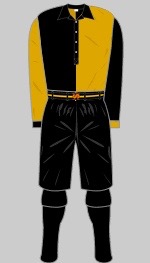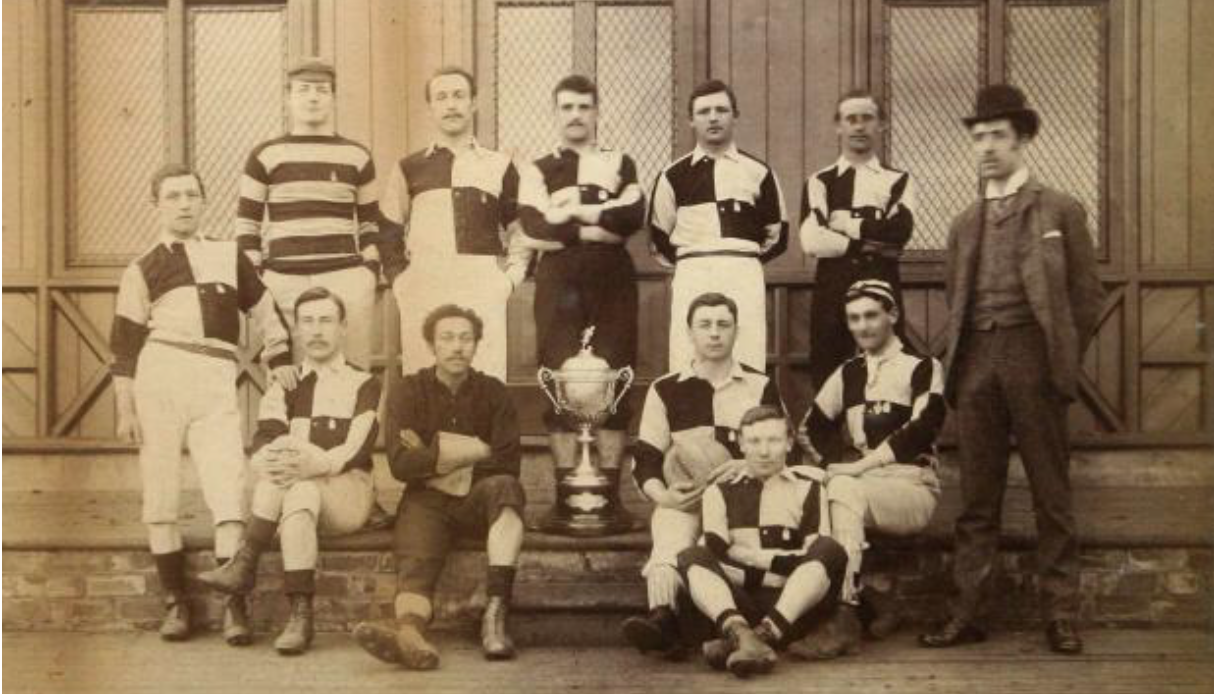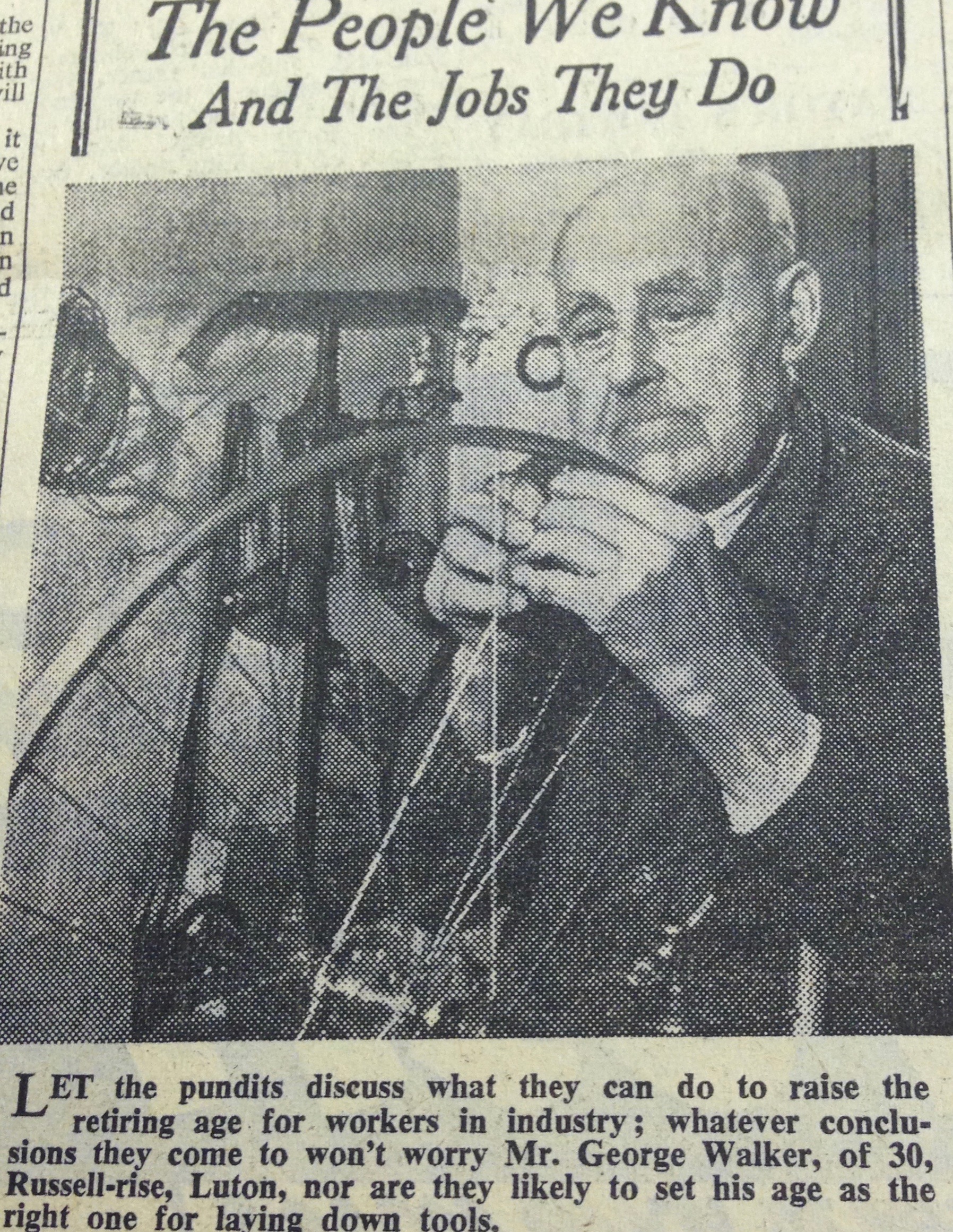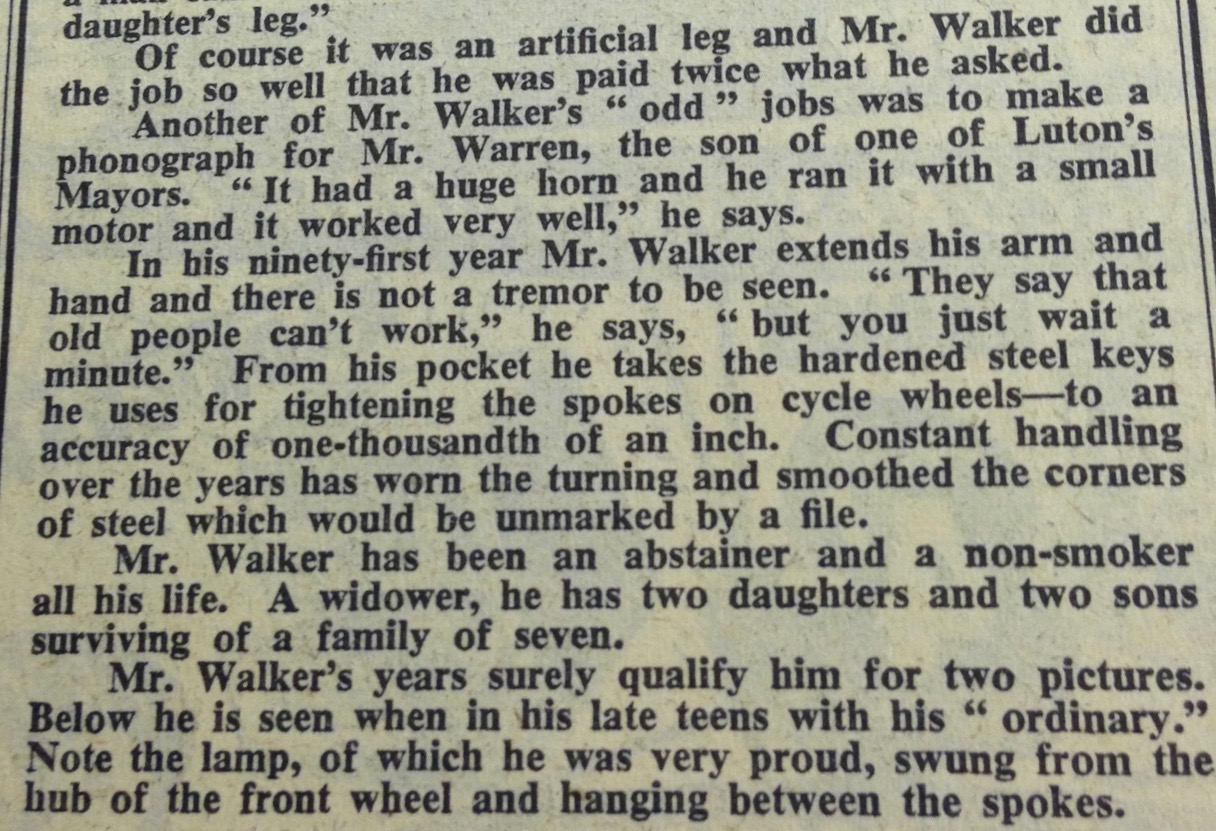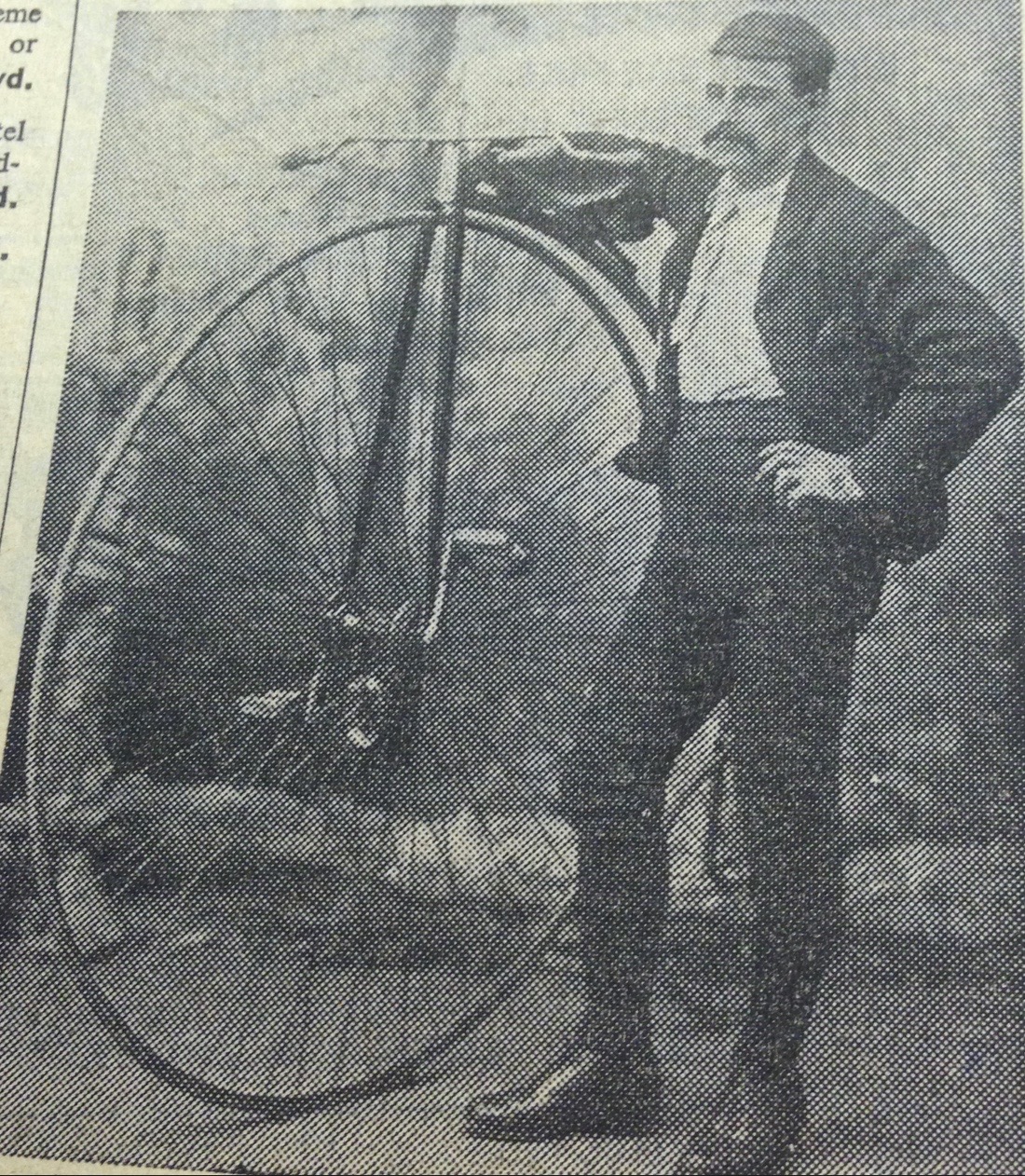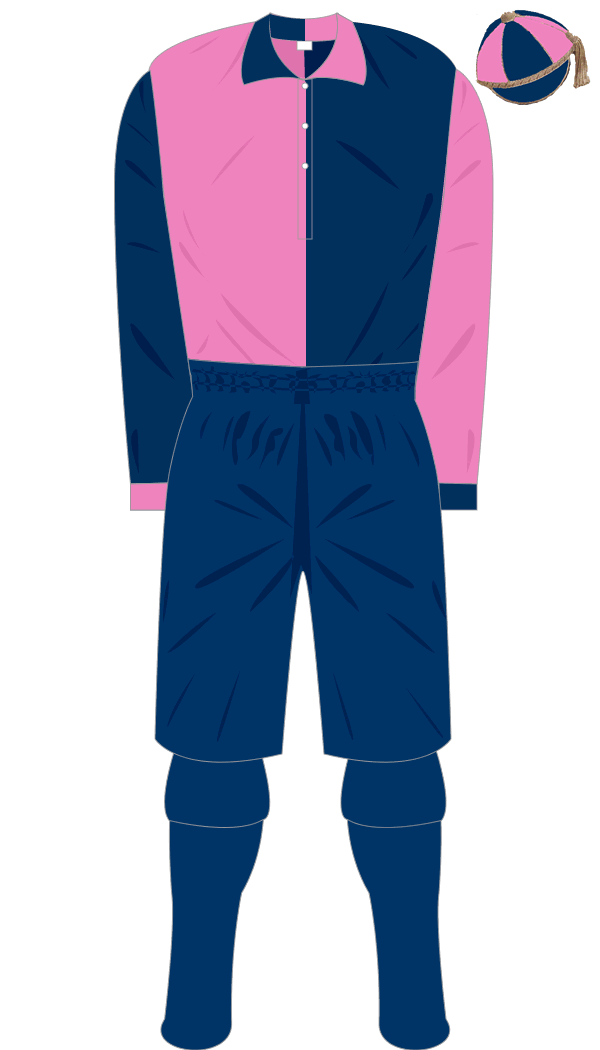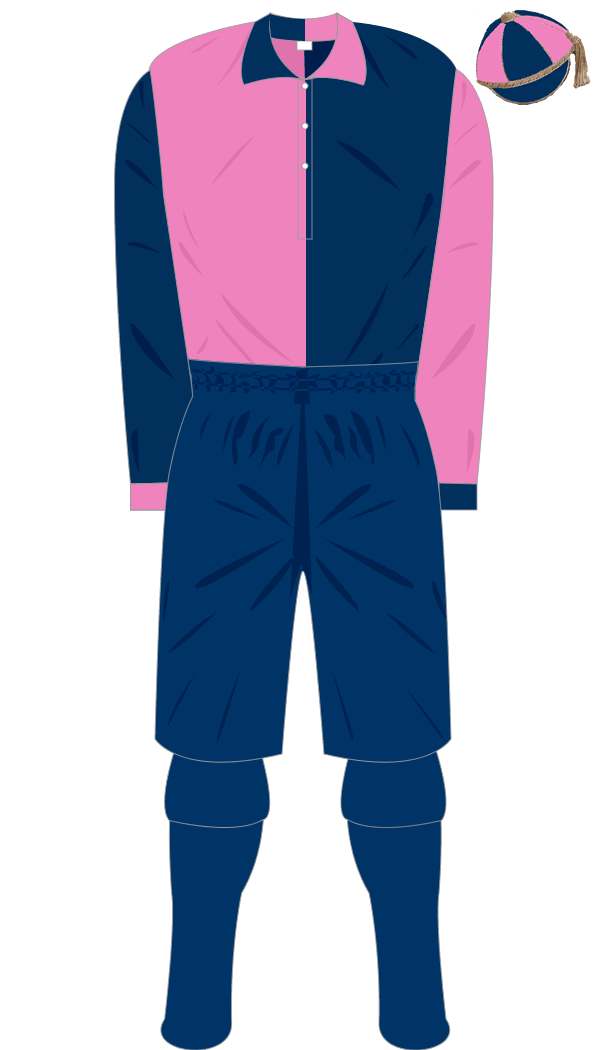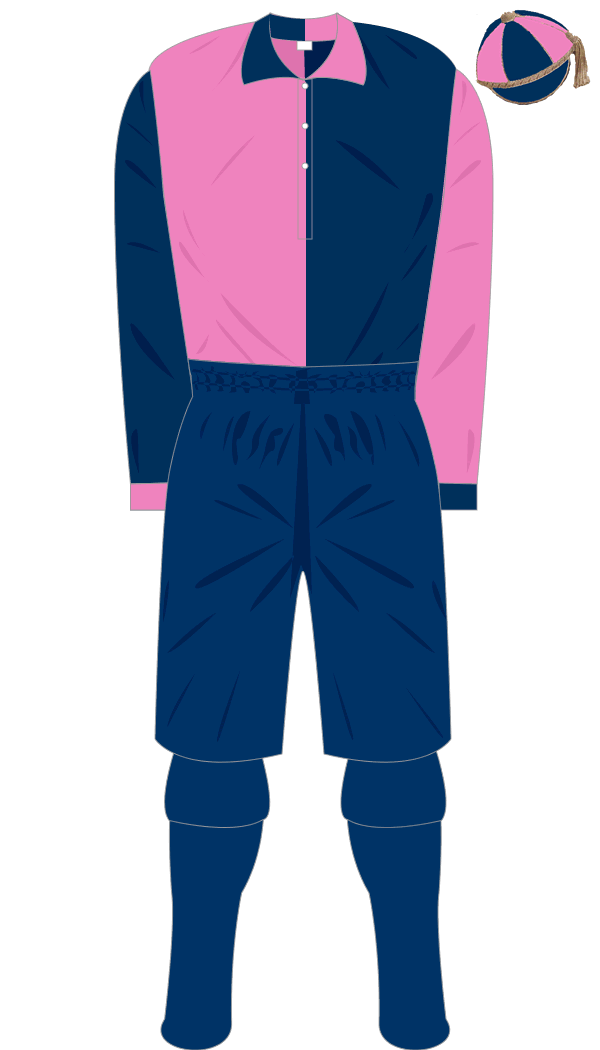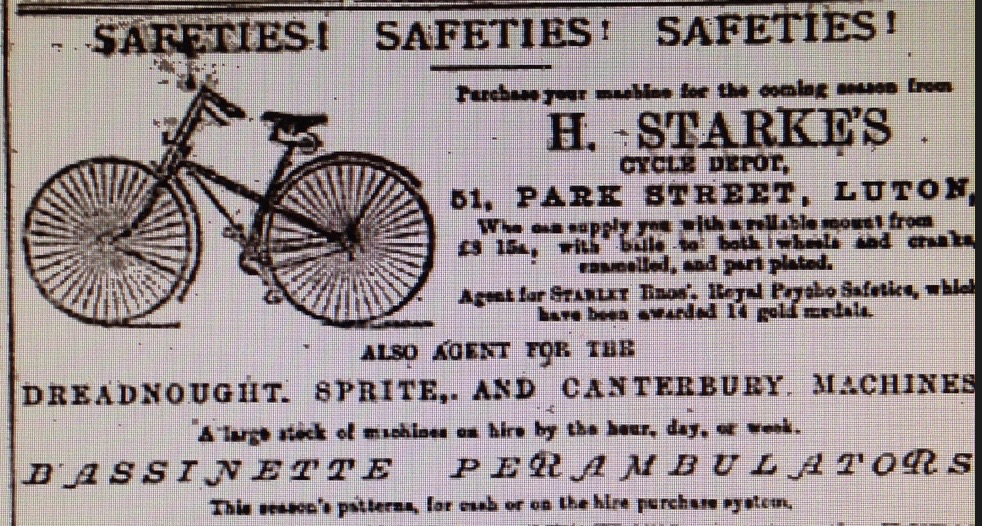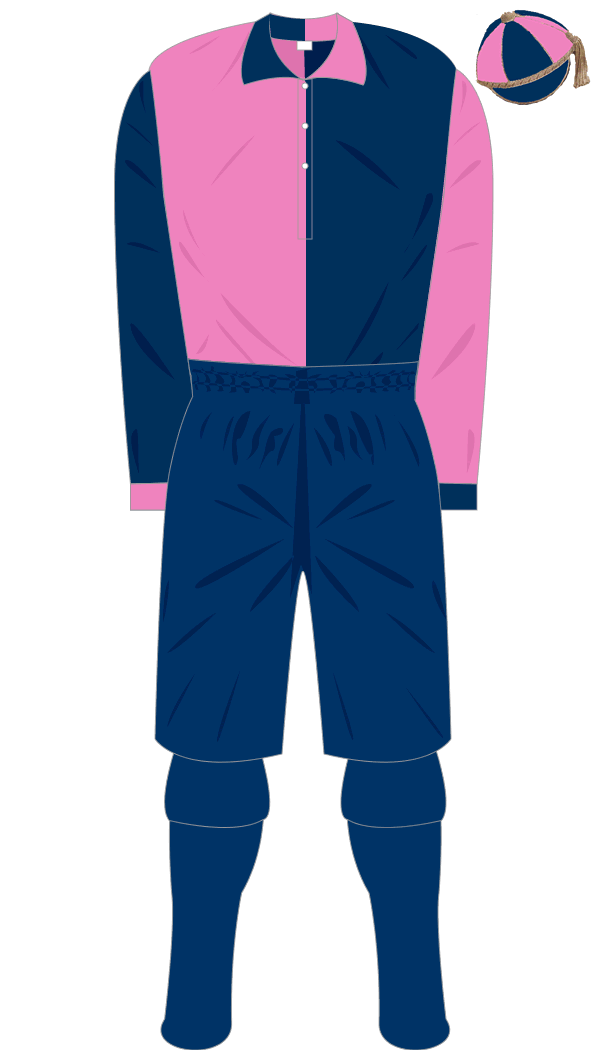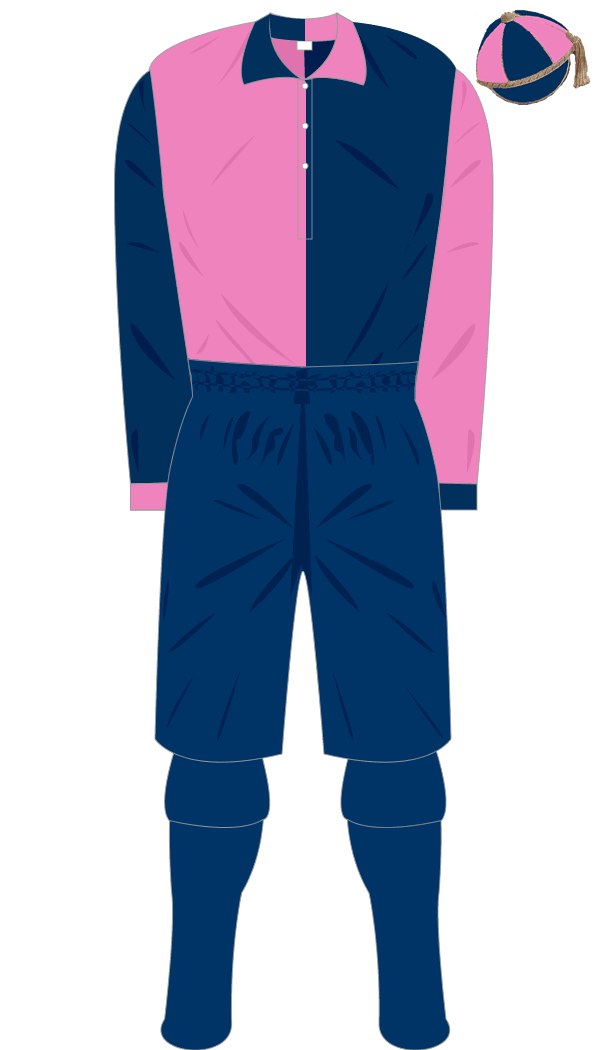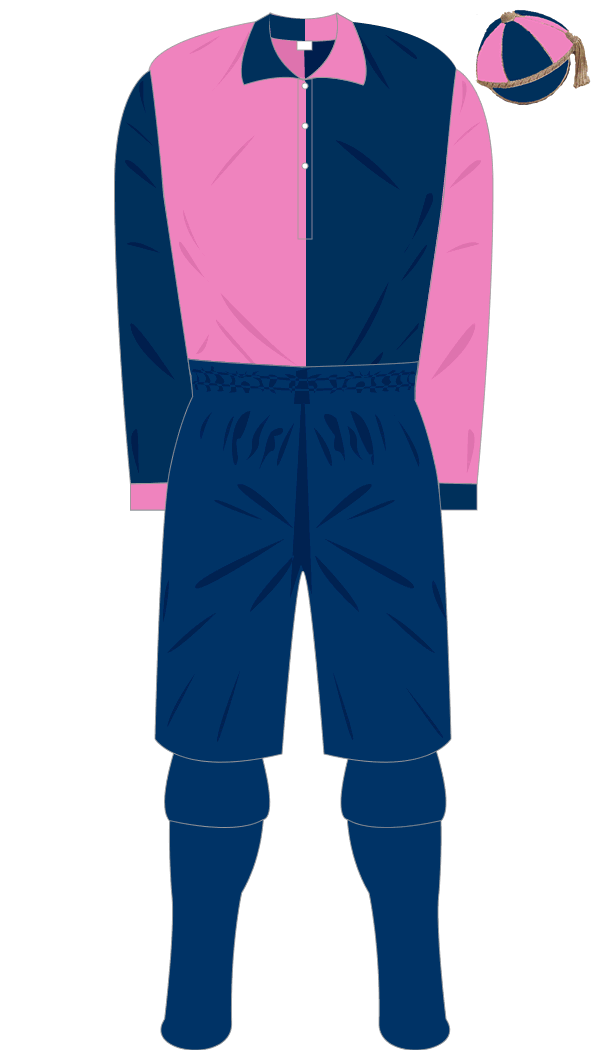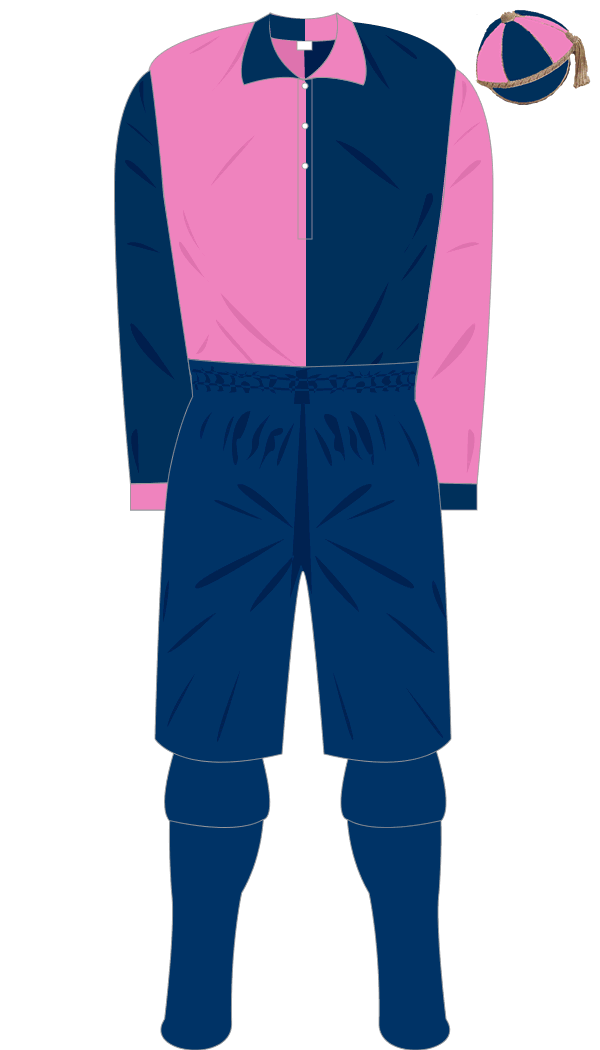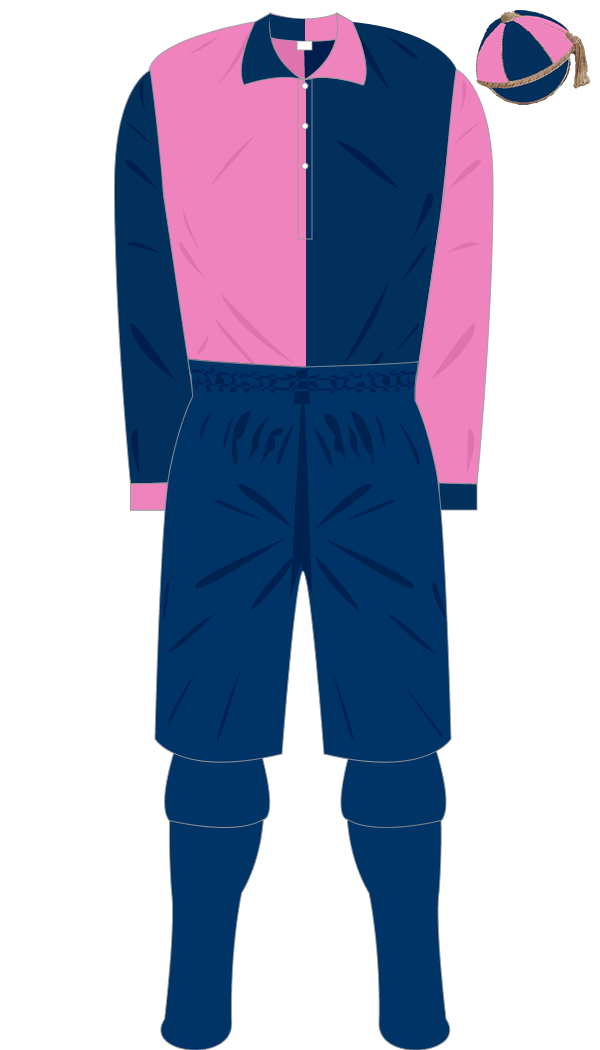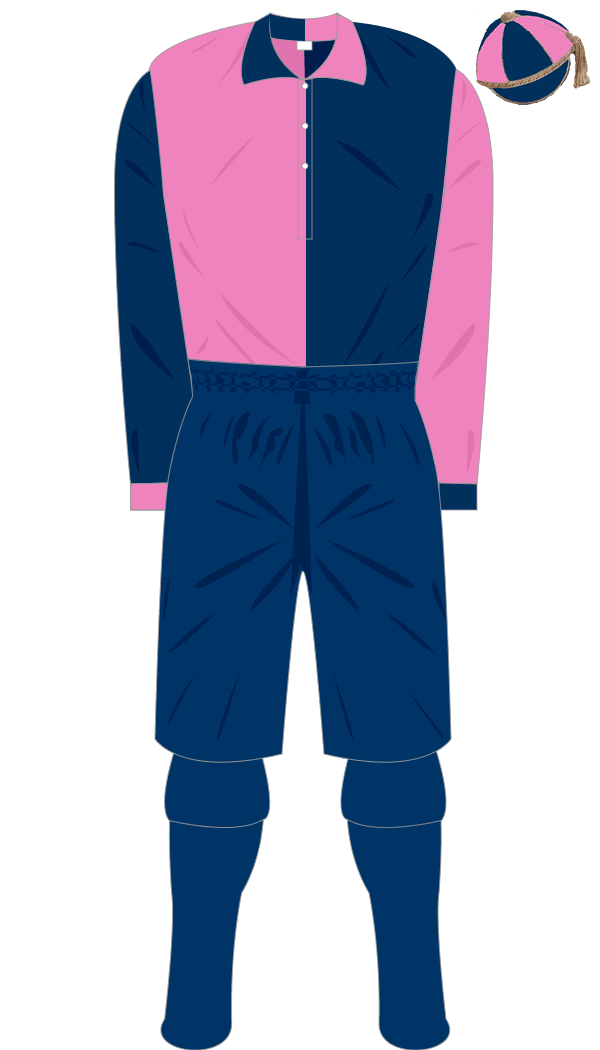CHAPTER 14. THERE’S ONLY ONE ISAAC SMITH – AUTUMN 1887
Page 1 – Another crisis, but worse than usual
Page 2 – Isaac Smith
Page 3 – The new Club Committee
Page 4 – Preparations for the new season
Page 5 – J.C. Lomax and the F.A. Council
Page 6 – The season begins, LTFC v Hitchin
Page 7 – LTFC v Lyndhurst and v Harpenden
Page 8 – F.A. Cup exit
Page 9 – LTFC v Limehouse
Page 10 – LTFC v Caledonian Swifts, Hitchin and Engineers
Page 11 – Who was “Darkie”?
Page 12 – LTFC v Dulwich and St. John’s College
Page 13 – LTFC v Hotspur and Dulwich
Page 14 – Christmas festival of football – 4 games.
If you just want to read the Luton Town football reports then scroll down to the pink and blue kits.
Crisis is a term used too often these days for mundane problems but the Summer of 1887 was a critical time for Luton Town F.C. The club had formed in April 1885 with high hopes but little progress had been made. Two F.A. Cup defeats had seen one goal scored and six conceded. The Wellingborough Grammar School had inflicted the club’s worst ever home and away defeats – 10 0 at home and 9 1 away. The weather had interrupted both seasons and a loss was made on the second season. There had been about 288 season ticket holders (known as members’ tickets) in the first season. This had reduced to 192 in the second season. The coming season would see this number reduced to just over 140 members tickets. This reduced the amount of advance money the club had to play with during the season. Money taken at the gate also fell from £54 15s 2d in the first season to £41 4s in the second season. The weather had played a part in the loss of revenue. However, the club appear to have paid their own train fares to away games and paid for the fares of teams travelling to play at Luton – an unsustainable practice.
There is no doubt that late kicks offs meant not only a discontented crowd but a crowd out of pocket. When players turned up late because of work in the morning, the crowd could be left standing in the cold and rain for a lengthy period, sometimes an hour. With the short winter months a late kick off would mean a shorter game. Games lasting 30 minutes or even less each way would not encourage spectators to spend their hard earned money and valuable leisure time on a game of football. Even the 1887 Annual General Meeting had started late due to late arrival of members. Isaac Smith, the Secretary, had again highlighted the prejudice against the club in some quarters – the newspapers. Matters took a turn for the worse after McLennan’s broken leg on the Dallow Lane ground. The newspapers would attack the game of football at every opportunity.
On the pitch, the star player and talisman, J.C. Lomax, had ended the previous season playing with St. Albans instead of the Straw Plaiters. His brothers sometimes turned out for the Saints too. To lose such a well respected player and gentleman would be a great loss on and off the pitch.
___________________________________
Page 2
It is not therefore an exaggeration to say that the club was at a crossroads. To the rescue came an unlikely and rarely mentioned hero. Isaac Smith was the Secretary and one of the most important men the club will ever employ. Not that he was employed at this time as he performed his duties unpaid. He attended almost every committee meeting, took the notes and acted upon the committee’s decisions. This involved hundreds of letters and telegrams each season. Isaac Smith would say later that it was the equivalent of one day’s work per week. In order to get through the work he would write his letters when he got home from the meeting at about 9.30pm. Correspondence to other clubs arranging games was only part of the job. Luton first and second team players had to be told where and when to turn up. Smith was ably assisted by his deputy, William Green Wheeler. Many clubs folded after a year or two because of the lack of a dedicated Secretary. Luton Town F.C. were extremely fortunate to have Isaac Smith.
Isaac Smith, left, gave his Secretary’s report at each AGM. These were no nonsense rallying speeches promoting the club at every opportunity. The following part of his speech is from the 1887 AGM which turned the fortunes of the club;
“The committee were, however, determined that in spite of all opposition the Luton Town Football Club should yet make its mark – (applause) – and to this end they were endeavouring to arrange matches with the best London teams.”
The committee may have agreed to this change of policy but I suspect that Isaac Smith was behind it. He was not just an administrator but a football enthusiast who showed great knowledge of the game and refereed Luton matches on occasions. The club turned towards organising fixtures against higher calibre clubs from London and vicinity – Ilford, Limehouse, Vulcans, Millwall Rovers, Dulwich, St. Brides, Woodville, Unity, Upton Excelsior, Bowes Park, Grosvenor (London), Hanover United, Clapton, London Caledonians and Old St. Paul’s. Some fixtures would not come off such as the Millwall and St. Bride’s games but games against Lyndhurst, Phoenix and Hotspur (from Wimbledon and not Tottenham Hotspur) were good replacements.
There are some formidable clubs on that list. The London Caledonians, formerly known as United London Scottish, would win the Middlesex Cup in 1889/90 and 1890/91. Hotspur had lost the final of the 1886/87 London Senior Cup. Clapton would win the London Senior Cup and the Middlesex Senior Cup in 1888/89. They beat Phoenix in the final of the latter. Lyndhurst had would win the Surrey Senior Cup in 1887/88 and be runners-up the following year. Millwall were strong from the start being joint winners of the East End F.A. Cup in 1886 and winners of the London Senior Cup in 1887, 1888 and 1889. Ilford would win the Essex Senior Cup three years running, 1887/88, 1888/89 and 1889/90. They would beat Upton Excelsior in the first year.
The Football League would begin the following season and would be made up of powerful northern and midland clubs. Football’s popularity was spreading south, slowly, but surely. A Southern League must follow. Luton Town had to improve in every aspect. It had to make it’s mark or it would be left behind. Fortunately, the Straw Plaiters had Isaac Smith at the helm.
_______________________________
Page 3
One final crisis arose as the committee prepared for the new season. The committee met on 9th August to discuss a letter received from Luton Cricket Club in which they stated that they would only let the meadow to Luton Town Football Club for matches for the sum of £12. This was nearly double the previous year’s rent. It appears therefore that the cricket club bought or obtained a lease on the meadow. It was agreed to offer the sum of 8 guineas (8 pounds 8 shillings) but the deputation was left to negotiate a price.
The new committee comprised of Messrs G. Deacon, W. Carter, C. Brown, W. Samwells, H. Shane, F. Hill, Steabben, H. Spratley, Miller, F. Beaver, J. Bennett, Pitkin and Scott. See the Hall of Fame for biographies of George Deacon, Walter Miller, James Bennett and Frank Pitkin. See Chapter six for a short biography of Herbert Spratley. See Chapter twelve for Frederick Scott, Charles Brown and Frederick Hill. I will set out some details of the remainder.
W. Carter. I have not been able to identify him. There were three William Carter’s in the 1890 Kelly’s Directory, a Dairyman, Grocer and a Straw Hat manufacturer. He could be any of them.
William Samwells. Born in Luton in 1863. At the time of the 1871 census he lived at 17 & 19 Bute Street with his parents who were Straw Hat Manufacturers. By 1881 he was lodging with Frank Pitkin’s mother at 23 Guildford Street. He was the nephew of Frank’s mother. William married Emily Ellingham (a big Luton family) in 1885 and by 1891 they lived together at 36 Collingdon Street. William was a Straw Hat warehouseman and they had a son, Fred. Sadly William passed away on the 1st April 1894 aged just 30.
Henry Shane. Henry was born in Luton in 1858. In 1861 he lived at 18 Victoria Street with his father, who was a bricklayer and his mother who was a Bonnet sewer. By 1881 he had married Sarah and lived at 4 Victoria Street. By 1891 he was a Straw Hat Manufacturer living with Sarah, a son and daughter at 15 Stockwood Crescent. They were wealthy enough to have a servant. Sarah died in 1904 and Henry remarried. In 1907 he wed Alice Maud Mary Johnson. At the time of the 1911 census he was still a Straw Hat Manufacturer and lived with Alice at 57 London Road. Henry died on the 11th June 1944 while living at 109 London Road. He left £1,400 17s 2d in his will.
F. Beaver. I have not been able to find any trace of this committee member.
Arthur John Steabben appears in the 1890 Kelly’s Directory as a draper at 44 Wellington Street. No other trace can be found under that name. There is an Arthur John Stevens, pronounced Stevvens, but I cannot pin him down.
___________________________
Page 4
There were no changes to the Laws of the game for the coming season. I will summarise the main points of the laws of the game;
The goalkeeper could handle the ball anywhere in his own half – but he could not carry it more than two steps.
Barging an opponent with or without the ball was allowed.
There was no penalty kick at this time.
All free kicks, corners and kick-offs were indirect, meaning they had to touch another player before being in play.
No free kick was awarded unless an appeal was made. The “advantage” rule was not introduced until 1904 so if you appealed for a free kick, you got it. The referee had no discretion to “play on” at this time.
Opponents could stand six yards away from corners, free kicks and goal kicks.
There is no use of the word “intentional” in respect of the handball rule.
There are no goal nets.
There are no substitutes allowed during the game.
A reminder that there were no leagues. Cup competitions, such as the F.A., County and Charity Cups, were the only competitive games there were.
***
The Straw Plaiters committee agreed that the Crown and Anchor was to be approached for a dressing room as per last season. The committee also agreed about the ground (Dallow Lane) and it was resolved that the papers be signed providing the ground committee find everything in order. They had secured the hire of the Dallow Lane ground for the season at a cost of £10. 250 match cards were ordered at a cost of £2. The club issued member’s with a “Member’s ticket and list of matches”. These were for the members who paid subscriptions, in other words, season ticket holders who paid the grand sum of 2/6 each (12 1/2 pence today). The following is Walter Miller’s member’s ticket. You can just make out his name on the dotted line on the second page.
More preparation for the forthcoming season were made in the following two weeks. Arthur Martin, the Town back, was appointed groundsman and paid 3/- a week. An interesting development is that the committee accepted
“Mr J. Dimmock’s offer of 7s 6d for permission to sell on the ground”.
This is the first mention of anything being sold at the match so the first money making commercial decision in the club’s history. Mr Dimmock sold nuts and fruit at matches.
__________________________
Page 5
Two teams were to be selected for a trial match to be captained by Messrs Hunt and J.C. Lomax. From the Luton Reporter dated 24th September;
“The Luton Town Football Club opened their season on Saturday with a match on their old ground at Dallow-lane, between teams captained by J.G. Hunt (treasurer) and George Deacon (the favourite forward). J.C. Lomax had been invited to be captain, but he was prevented from accepting that position. The ground was in good order though somewhat slippery. The positions of the goals had been slightly but advantageously altered, since last season. Between 200 and 300 spectators were present. J.G. Hunt’s team consisted of Hunt and Martin, backs; Bird Wright and Underwood, half backs; Smart and Hills, right wing; Small and Brown, left wing; Wheeler, centre with Boxford in goal. George Deacon’s eleven was formed of Deacon, Miller, Spratley, Looms and Low (centre); forwards; Munro, Read and Plummer, half backs; Sanders and Moody, backs; with Mileman in goal. Messrs Bennett and Smith were umpires. The sides were evenly matched and a fair game was carried on all through. Martin, Hunt, Small and Smart rendered good services, the former scoring a goal off hands. Hunt showed his usual form. Small sent a fine shot from centre which, however, failed to go through the goal, the keeper putting it over the rail, giving a corner, which however, was made nothing of. Geo. Deacon on his side made one or two capital runs during the latter half of the game, and Miller kept well up in his place, Spratley and others working well together, whilst Sanders and Moody kept the ball well in the play. The game ended in each side scoring one goal”.
The minute book begins to record the gate receipts and it shows that £1 14s 8d was taken. If it was 2d admission that makes 198 spectators plus the members.
The Football Association had been re-organised and now had 32 governing rules.
The Luton Times shows that on Monday the 26th September,
“at the general meeting of the English Association held in London on Monday, Mr J.C. Lomax, of the Luton Town Club, was elected to represent the division which included Bedfordshire, on the Council of the Association. There were two other gentlemen nominated for the division, viz., Mr F. Sherrington, of Oxford University and Crusader Club, and Mr J.P. Rowlinson of Cambridge University. This is an honour for the Luton Town Club, and no doubt Mr Lomax will prove as of good service on the Council as in the football field”.
The F.A. Cup had a record number of entries the previous year and some of the teams were weak. Preston had beaten Hyde 18 0 so a qualifying system was put in place for the weaker clubs. They were organised in a regional knockout tournament, initially of 16 clubs, with just one club going through to the first round proper.
J.C. and E.H. Lomax played for St. Albans again on the 24th September but not again until January 1888. The brothers Lomax were committed to the Straw Plaiters.
______________________________
Page 6
On 1st October;
“the Luton Town Football club played a second match on their ground at Dallow-lane on Saturday, the teams being chiefly selected from the members. Nothing of any note transpired. The object was more to prepare the way for the three coming matches, the first being to-morrow (Saturday), when Hitchin Club are expected to bring their cup tie team, who are said to be tolerably well up to the mark, so much so that Luton Club have selected a strong team comprising many of the players who play Chatham team in the cup tie in the first round on Oct. 15th. Consequently some good play may be witnessed on Saturday, and should this turn out to be the case there will be little need to alter the present selection for the London Scottish team due to play here on Saturday, Oct 8th. This Club scored last year on Luton ground three goals to two, although last Easter Luton scored one to nil with the same team. The charge at the gate is twopence, but the cheaper way is to have a season ticket”.
The gate receipts for this practice match was 9/10.
This was a practice match but the report tries to rally support and mentions a season ticket. We know that 2d was charged at this time for matches so our estimates of attendance can be fairly accurate if we have the match receipts. The unknown factor is the number of season tickets holders who did not pay on the day.
The Luton Reporter continues;
“A committee meeting of the Football Association, held at Anderton’s Hotel, London, on Monday, Mr J.C. Lomax of the Town Club, was elected a representative of the local division upon the Council of the Association”.
***
The Luton Reporter contained a report of the Hitchin match on 1st October;
“a well-contested match was played last week on the ground at Dallow-lane between Hitchin and Luton Town Football Clubs. Shortly after four o’clock the ball was put into motion by the visitors, and not many minutes passed before J.C. Lomax secured the ball and made a well-directed shot at the visitors’ goal, but it went over the rail. Shot after shot was made, but without effect, first by Smart, then by E. Lomax, and the next T. Small, several corners were given affording the Town Club opportunities for securing a goal but the opposing goal-keeper was equal to the occasion, and merited well the applause given him by the spectators. During the first half of the game, the ball was very much kept in the Hitchin territory, although their forwards broke away several times, and at least once was within an ace of scoring; but that promising Luton back, Sanders, was in his place, near the goal and splendidly saved the downfall of the Luton colours. Half-time was called, the teams set to work again. The Hitchin men had now the wind in their favour, and soon showed up well. They seemed to settle down in their places, and some pretty passing was the result. They were, however, too weak in their forwards, whose every effort to score was cut-down by the combined play of the Luton backs and half-backs. No doubt remains that the sides were evenly matched as was shown by the game ending in a draw. The names of the Hitchin players are not to hand: those of the Luton team were :- Goal – Mileman. Backs – Hunt and Sanders. Half backs – Read, Munroe and Moody. Forwards – J.C. Lomax, centre. E. Lomax and Smart right wing. Small and Miller, Left wing”
Mileman made his first appearance. He had been around for some time and it appears from the reports of local matches that he was the best goalkeeper in town. The club had tried many different goalkeepers who were also known for their outfield play. It must have dawned on the players and committee that goalkeeper was a specialist position and needed someone to play there regularly and build up a partnership with the backs.
“The match arranged with the London United Scottish and the Luton Town Club being scratched, owing to the London Cup Tie having to be played off, arrangements have been made for the Lyndhurst Club to visit the town to-morrow (Saturday), when a good game is expected, Lyndhurst being a strong team, and the home team considerably stronger than last week”.
_____________________________
Page 7
Lyndhurst did turn up for the match on the 8th October. The Luton Reporter gives a very short report;
“The contest was well maintained throughout, and doubts were entertained as to the probable result. The game however, ended in favour of Luton, two goals to one”.
The Luton Times had a more comprehensive report;
“A very good match was played between the above clubs on the ground of the former in Dallow-lane on Saturday last. The game was evenly contested throughout, first one goal being in danger then the other. Mr Barber, a new member of the Town Club, made a promising debut, scoring the first goal in a first-class fashion: he played well and kept pace throughout the game. The visitors, put on their mettle by this reverse soon carried the ball into their opponent’s territory and equalised the score amid the cheers of the onlookers. The game now proved very exciting, each team striving their utmost to gain the winning point, but it was not obtained until time was nearly up, when Munroe from half-back, sent in a hot shot, which the custodian was unable to save, the Luton team therefore winning a very pleasant and fast game by two goals to one”.
The Town also sent a team to Harpenden
“which resulted in favour of Luton by four goals to two”.
The Luton Times notes that
“Messrs Whitby, of Luton, played for Harpenden”.
Had the brothers Whitby deserted the Straw Plaiters? We do not know why they chose to play for Harpenden.
The Luton Times announced that for the Cup Tie at Chatham the following week that
“the Luton team leaves the Midland Station at 9.35. Members and friends wishing to go are requested to be at the station at the time named”.
____________________________________
Page 8
149 clubs entered the F.A. Cup and went straight into the first round. Preston’s 26 0 win over Hyde in the first round caused qualifying rounds to be talked about. The new Football League, which would begin for the 1888/89 season, also played a part in the introduction of qualifying rounds to reduce the number of games for the bigger clubs.
The Committee chose the team for the first round of the cup and Mr Bennett was chosen as the Town’s umpire for the game on the 15th October.
“A team of the Luton Town Club journeyed to Chatham on Saturday to play Chatham Town Club, in the first round of the English cup tie, the Luton players being C. Lomax, centre; E. Lomax, T. Small, left wing; G. Deacon, A. Smart, right wing; Read, Taylor and Moody, half backs; Martin, Sanders, backs; Mileman, goal. The team, with two exceptions, left Luton by the 9 36 train, but did not reach Chatham until nearly two o’clock. Some 3,000 or 4,000 spectators witnessed the play, and from the beginning to end the Luton men were received with great courtesy. The respective teams settled down to work about the time appointed. A strong wind with rain did not augur well for Luton, several good shots being carried just over and alongside their opponents’ goal, and at least two goals should have been placed to the credit of the Luton Club during the first half of the game. Meanwhile the Chatham team were playing in that combined style which meant business, their centre-forward and backs exhibiting fine form. After changing ends, the Luton secured a goal, but although their forwards played well together their efforts were fruitless. Their opponents, it was seen, were too strong for them, and ultimately the home players proved themselves to be the best team, by scoring five goals to one”.
The Luton Times also covered the game.
“English Association Challenge Cup, Luton Town v Chatham. This tie in the above competition was played on Saturday October 15 on the ground of the latter club in the presence of over 3,000 spectators. The game was evenly contested, although more so than what the result shows. The Chatham team were a strong lot, playing five county men and several officers from the regiment quartered in the town and were the best team. The Luton men being tired with their long journey, did not play up much at first, but warming to their work the forwards put in a lot of good work and played a remarkably good game, in fact, the best game they have played this season, and were only prevented from scoring by the remarkably good defending of the home back division. Read and Moody were the best of the half backs, whilst Saunders played a grand game at the back, Martin being quite out of form and could not kick at all: Mileman’s play in goal being all that could be desired, the shots that did go through being quite impossible to stop. The home team won the match by 5 goals to 1”.
This is a huge attendance for a provincial team – we shall find out why later in the season. Chatham would beat the Royal Engineers at home in the second round but lose at Crusaders in the next round.
The second team also met with a heavy defeat at Ilford losing to a strong team by four goals to nil according to the Luton Recorder. The Luton Times says it was 1 0.
Perhaps a sign of the growing rivalry, the Luton Times mentions that Watford Rovers lost at Chesham 4 2 in the same round of the cup. They also mention that Hitchin beat the Old Wykehamists by 5 goals to 1.
_____________________________
Page 9
The 22nd October the Town were back on track against Limehouse.
“A fair match was played on the ground in Dallow-lane on Saturday between the above teams. In five minutes the visitors scored off Moody, but shortly thereafter the Luton team equalised matters. Some scrimmages followed in the Limehouse goal, but “Darkey” well fisted the ball, and so saved several shots. But by some fair passing a second goal fell to Luton. After half-time Deacon scored a third goal for Luton. At this point the opponents’ forwards played up, keeping the ball in the Luton territory, and for a time much give and take play was witnessed. Luton, however, obtained two other goals. The Limehouse were unable to score again. The play ended in five goals for the home team and one for the visitors. The Luton team were as follows:- G. Folks, goal; Martin and Sanders, backs; Moody Read and Mileman; Deacon and Small (right), C.J. Lomax (centre), Miller and Smart (left), forwards”.
The Luton Times report of the Limehouse game adds some vital information about the whereabouts of the pitch itself.
“They won the toss and elected to play towards the railway end”.
This shows that the goals backed on to Dallow Lane and the railway line at this time.
The report continues;
“The visitors started the ball, and it was carried down by their right wing and centred right in the Luton goal, and Moody attempting to save it missed his kick and the ball rolled through, the visitors thus drawing first blood. The home team from the kick-off carried the ball into their opponents’ territory and the ball was shot past their custodian by Smart in a rattling fashion, making the score even. Some even play now resulted and nothing further was scored until nearly half-time, when Miller made a splendid shot which just dropped under the bar and went through. The second goal for Luton was scored and soon after the whistle blew for half-time. When ends were changed the home team had matters much their own way, and shot after shot was sent in at the opponents’ stronghold, but they were kept out in a marvellous way by the goal-keeper, nothing being scored until within 20 minutes from the re-start, when Munroe sent in a splendid corner which was kicked through. Smart and Small now from both wings put in some good runs and middled right into the goal, but the centre man was not up and the chance to score was lost. Small, about 15 minutes from the finish, centred the ball right into the goal when it hit the bar and bounced back into play and Deacon rushing up breasted it through. Another goal was soon afterwards scored from a corner by Read who dropped it in the mouth of the goal and it was hustled through. Soon after, the whistle blew for time, and the home team left the field victorious of a very pleasant game by 5 goals to 1. The Luton team nearly all played well. Lomax seemed quite out of his place as centre and lost several chances of scoring as when the ball was centred into goal he was not up in his place and the goal keeper had plenty of time to get them away. Miller played well at times, but now and then seemed a little funky. Sanders tackled splendidly, and played well all through the game. Smart made some good runs and centred the ball as well as could be wished and Small as well, only the last named has a tendency to lag behind his forwards”.
That is the first criticism of J.C. Lomax we have seen. Playing at centre forward and barging the goal keeper and making a nuisance of himself does not seem fit his personality.
Note the nickname used for the Limehouse goal keeper. “Darkey/Darkie” was a nickname applied to black people such as Arthur Wharton, the famous black goalkeeper of the era. It was also applied to white men with black hair. It is the first time a nickname has been used in a line up. More of this later.
The Town squeezed in a mid week game;
“Town Club v Grosvenor College. – Played in the Town Club meadow, Dallow-lane, on Wednesday afternoon, and resulted in a win for the Town by four goals to one. The Town team was: A. Underwood, goal; A. Sanders and E.P. Hughes, backs; J. Wright, C. Brown, and A.C. Sanders, half backs; E. Ellingham, W. Wheeler, right; F.W. Hill, T.B. Knowles, left; H.G. Spratley, centre, forwards”.
_______________________________
Page 10
The last weekend in October saw Luton Town play Caledonian Swifts.
“in the presence of the largest gathering of spectators this season, a pleasant well contested game was played on the Town Club’s ground, Dallow-lane, against the Caledonian Swifts on Saturday afternoon. At 3 o’clock the ball was started, and after fifteen minutes low play A. Smart ran the ball up the field, passed it to G. Deacon, who put it to C. Lomax, and by a low, quick shot secured a goal for the Town team. This was vociferously cheered. The visitors then seemed to pull themselves together, and getting hold of the ball H.S. Magan smartly passed it to centre, when it was shot in goal, but Mileman cleverly fisted it out. Afterwards G. Deacon made a splendid run, and passed the ball to C. Lomax, who, however, failed to score. Nothing further occurred during the first half of the time, except a little hard luck for both sides. When ends were changed the home team repeatedly brought the leather down the the Swifts’ goal. Here three or four corners were claimed in quick succession , but for want of judgment these advantages were lost. At this time off-side was declared by the visitors. The ball had been brought up to the goal line by A. Smart, and when about to concede to the appeal G. Deacon, who was in play, passed some of his opponents, took the ball and immediately shot it back into play. Here A. Smart played again on the ball, and shot it well towards goal, and Deacon running forward touched it, but failed to screw it enough to score a well deserved goal. Soon afterwards another capital run down the ground was made by Deacon, but without effect. T.H. Small and also H. Boxford played a good game; indeed, not a man in play did bad service. The centre of attraction (when his presence became known) was the fine tackling of Hugh McIntyre and M.N. McFie, the visitors’ backs. The former gave the company a taste of the science in the game of football, as with few exceptions H. McIntyre’s play was faultless. This player has played twice in the final for the Association Cup with the celebrated Blackburn Rovers. The Caledonian half-backs played well, and had the forwards been in better form much tougher work than was seen must have been the result, and although the game ended in favour of Luton – vis, one goal to nil the Caledonian Swifts take a lot of beating. The Town Club was represented by J. Mileman, goal; A. Martin and A. Sanders, backs; E. Munro, T. Read and G. Moody, half-backs; G. Deacon, A. Smart, J.C. Lomax, H. Boxford and G.H. Small, forwards. A lively game will be played on the above ground next Saturday, between the Town Club and Engineers”.
The Luton Times report is as follows;
“Played on the ground of the former club in the Dallow-lane on Saturday last. There was a large number of spectators present to witness the game, which proved to be a very interesting and exciting one, in fact being the best game that has been played this season. The Scots brought down a very strong team including McIntyre, who played for the Blackburn Rovers at the Oval in the Final Tie for the Association Cup 1886, and made sure of winning, but had to return to London disappointed, as the home team played a good game and scored first. , and as no other point was notched for either side the Town Club retired victors of a splendidly contested game by one goal to none. The Scots started the ball at 3.45, and rushed it up the field and Sanders put it behind, but the corner kick proved of no avail. From the goal kick Deacon obtained possession and passed the leather to Smart, who in turn centred it to Lomax, the latter putting it through with one of his old screw shots at a clinking pace, completely baffling the custodian. The visitors, stimulated by this reverse, tried their utmost to score but were unable to do so, Mileman saving his charge in splendid manner on two or three occasions. The game from now until the finish was evenly contested, neither side having the advantage for long together, and when time was called the result was as stated above. Mileman and the backs and half-backs played a splendid defensive game for Luton; with the exception of Munroe, who has not got used to his place in the centre yet, the forwards all played a better game than last week. Boxford being an improvement, he tackling McIntyre in splendid style. Smart and Small made some fine middles and in fact, the team all round improved on their last week’s form”. The report includes the Swifts team; “W. Chalmers, goal; Hugh McIntyre and M. McFie, backs; H. Fisher (captain), H. Butler and A. Burgess, half-backs; R. Rogers, H.S. Magson, D. Brown, C.H. Brown and R. Elliott (forwards).”
The committee meeting on 1st November showed that the Swifts game raised £2 10s 2d in gate money thus giving us a crowd of 300 plus members. They also resolved that
“the Engineer club members be admitted to both matches on producing their card of membership”.
Engineers were one of many of the local clubs that survived the formation of Luton Town Football Club. Luton Albany, Luton Rovers, St. John’s College, Christ Church Choristers, Grosvenor College, Engineers, Victoria Rangers, Ramblers, Frontier were all still playing regularly. A new team also played this weekend, Luton Forest beat Leighton Wanderers two nil. Some familiar names appear in their team made up of Geo, Worboys, J. Bird, J. Burley, A. Gazeley, C. Butler, L. Abrahams, S. Parsons, G. Folks (the goal keeper playing at left wing), W. Litchfield, H. Lowe and H. Hill.
***
The 5th November saw two Luton teams turn out. The first team travelled to Hitchin. The Luton Times takes up the story
“was a very fast game from start to finish, the teams were equally matched and a well contested game ensued, although several attempts were made by both sides to score, neither were able to do so, owing to the good defence of the back division of both teams, and a very pleasant game ending in a draw, nothing being scored by either side, this being the second drawn game the above club has played this season. The Town Club were somewhat handicapped by the absence of the brothers Lomax, and A.H. Taylor who fell out on Saturday morning, and Boxford, Miller and Moody had to go in their places. W. Barrett made his first appearance this season and played again in his old form, doing very useful work with his head at times. The Luton team was as follows: Mileman, goal; Sanders and Martin, backs; Barrett, Read and Moody, half backs”.
The forward line is missed off the report.
The Luton Times says that the second eleven met the Engineers
“on the Town ground, Dallow-lane, Luton. The Town Club had three of their men go to Hitchin, and others had to be obtained in their places, which made their team rather weak forward. It was a very good game although a little rough at times. The Engineers obtained the first goal amid the frantic cheers of their partizans. The Town team ought to have scored on several occasions, but the left wing and centre were of no good at all and missed the ball several times in succession. When the sides changed over the Town made several determined onslaughts on their opponents’ citadel and managed to lower their colours mainly through the combined play of Smith and Spratley on the left wing. Both teams now made great efforts to score the winning point which was at last scored out of a scrimmage, Spratley giving it the last touch. Soon after the whistle blew for time and the Engineers had to retire disappointed and defeated by 2 goals to 1. The Luton team was as follows; “Darkie”, goal; F.W. Wigg and Monroe, backs; Underwood, Wright and Small, half backs; Spratley and G. Smith, left wing; W. Hill, centre; F. Hill and C. Brown, right wing”.
Note the Town goal keeper, “Darkie” plays his first game.
_____________________________
Page 11
We move onto the 12th November when a team travelled to Bedford and lost four one to a “stronger team and included several special players”. The Luton Times gives us a better report. “Played at Bedford on Saturday. The Luton Club went down with only nine men and the Bedford team were strengthened by Partrick, the Old Carthusian, who is visiting the town and who obtained all the goals that the Bedford club were credited with. It was a fairly even match considering that the Luton men had to obtain two subs on the ground who did more service to the Bedford team than to the side they were playing for. The game resulted in a win for the home team by 4 goals to 1. Luton were represented by the following:- Mileman, Martin, Sanders, Read, Moody, Lomax, Miller, G. Smith and R. Ellingham”.
Another Town team played Luton Rangers. It is not clear why first team regular, George Deacon, is in the reserves when the first team only had 9 men at Bedford.
“Teams of the above clubs met and played a friendly game in the Dallow-lane ground on Saturday. Much pressure was put on the Rangers, who, however, managed to play the first half of the game without either side scoring, although several good shots were made, Deacon especially making one long shot which hit the top of the rail and bounded over. On recommencing the Town were first to score. The Rangers then played up and by some fair passing, quickly equalised matters. The next goal was breasted through by Brookes, and a third was scored in a similar way, this leaving the Town Club winning by three goals to one. The Town team was as follows:- “Darkey”, goal; J.Hunt and Munro, backs; Wright, W. Hill and Smith, half-backs; G. Deacon, T. Small, Spratley, and Brookes, forwards; Boxford, centre.
The Luton Times gives us more details.
“Played in the Dallow-lane, Luton, on Saturday, and was a very evenly contested game all through. Nothing was scored for either side in the first half owing to the slippery nature of the turf making accurate play impossible. When ends were changed the Rangers played up well, and secured the first goal owing to the bad play of the Luton goal keeper. The town team stimulated by this reverse , now began to play up a bit in their old form, the forwards passing to each other; at last Spratley ran the ball right up the left wing, centred it across the mouth of the goal and Boxford kicked it through. Brookes, a few minutes after, finished up a good run by shooting through, and a few minutes from time a determined rush was made on the Rangers citadel which was again stormed. Deacon kicking a third goal , a very good game and a pleasant one, ending in a win for the town team by 3 goals to 1”.
The two reports clash on the sequence of the first two goals. The Luton keeper is confirmed by the Luton Times as “Darkie”.
Did “Darkie” come up from Limehouse to play for the Town on trial? This is the first occasion that a nickname has been used instead of the players real name. Some people were known as “Darkie” because of their black hair and unshaven complexion. But they were always described by their surname in match reports. See the newspaper clips below from the 1930’s looking back on “Darkie” Walker, a well known Luton cyclist.
Here, we just have the nickname “Darkie” which is unprecedented in this period. He could have been a real character who referred to himself by his nickname and would not give any other name to the reporter. I had hoped that the player was Arthur “Darkie” Wharton. Arthur Wharton is generally considered to be the first black professional footballer in the country. He came to the country to study in 1882 and was a goalkeeper and played for Darlington and Preston. He was famous for punching the ball, an account of which we specifically see in the Limehouse match report. He had been the AAA champion at the 100 yards in 1885 and 1886 and World record holder since the latter date. The circumstantial evidence all fits. I imagined that Wharton needed to keep his identity secret because he was under contract to Darlington or Preston, so he used his nickname. As already mentioned, he was a goalkeeper who liked punching the ball. He also visited London regularly for athletic meetings so could have asked Limehouse for a game. However, my hopes were dashed because I located newspaper articles which confirmed that he was playing elsewhere on two of the three dates mentioned above. It is still possible that “Darkie” could be our first black player but we do not have any confirmation.
NOTE on the photograph. Wharton wears gauntlets instead of gloves. This confirms he had a sensible preference for punching the ball. Catching was not advisable due to barging being favoured by most forwards. Whoever “Darkie” was, he gave away a goal against Luton Rangers, and the committee continued their search for a new goalkeeper.
______________________________
Page 12
Harpenden failed to turn up at Dallow Lane the following week. According to the Luton Times the Town;
“Were served in an ungentlemanly manner by Harpenden who never turned up and did not send any information that they were not coming or the reason for it.”
Arthur Martin failed to turn up for the first team who travelled to play Dulwich. It will be remembered that the Town narrowly beat Dulwich 4 3 when the latter had ten men. The Town therefore got a hiding losing seven nil. The Luton Times has a full report.
“The Town team were poorly represented at Dulwich on Saturday, playing only with ten men for the first half. Small missed the train at Luton and did not get down to Dulwich until the game was half over; A. Taylor and Barrett were unable to go and Martin did not go as he said he was too ill to play, but we learn that he was able to play at Wheathampstead notwithstanding his illness. The game was a fairly good one considering that the Lutonians were handicapped by the absence of three of the three back division and also playing one short for above half of the game. The Home team won somewhat easily by seven goals to nil. The following played for Luton:- Mileman, goal; Sanders and E.H. Lomax, backs; T. Read, Moody and Hills, half backs; G. Deacon, Smart, J.C. Lomax, Bowker and Small, forwards”.
The committee were not at all happy at the next committee meeting.
“After the former business was over Martin’s treatment to the club was freely discussed after which it was unanimously resolved that the Honorary Secretary should inform Mr Martin that the club would not require his services as ground man after Saturday Nov 26th.”
Arthur Martin had been playing for St. Albans on occasions. We do not now what excuse J.C. Lomax and his brothers made to the committee when they decided to play for the Saints instead of the Town. Arthur Martin had been publicly exposed in this report by saying he was too ill to play at Dulwich but fit enough four days later to play at Wheathampstead. The Committee were ruthless in their action.
***
The end of November saw St. John’s College (Past and Present) meet the Town.
“On Saturday a football match was played in the Dallow-lane between the eleven of Luton Town and a team of St. John’s College, the College playing past and present pupils. The game was chiefly remarkable for its fast character. The Town turned out a strong team, including such well-known players as Saunders, Read, Smart, Deacon and Small with Hunt for a back; whilst the College could boast of the Lomax’s, Simpson, Beldam, and other familiar players. In a very short time the college scored two goals, both kicked by J.C. Lomax, who as usual, made himself conspicuous by his brilliant forward play. T. Small moved for the Town, a claim of “off-side not being allowed. These were the only points scored in the game, which owing to a strong wind was played under difficulties. The College team appeared to be the stronger of the two, and a pretty combination game was played by the forwards, the passing being of a superior kind to that generally seen in Luton. For the College D.A.N. Lomax, Wright and Beldam (forwards) distinguished themselves, whilst the same may be said of Mileman (goal), who had pretty warm work at times, Saunders (back), Small, Smart and Deacon (forwards). The result was in favour of the College, who won a pleasantly contested game by two goals to one. Teams: St. John’s College (past and present). Goal, E.T. Jones; backs, D.A.N. Lomax and E.H. Lomax; Half backs, T.W. Simpson, A. Kershaw and P. Berridge; forwards, G.W. Beldam and E.H. Wright (right wing); J.C. Lomax (captain), centre; L.W. Wigg and J.B. Furlong, left wing. Luton Town. Goal, Mileman; Backs, Saunders and Hunt; half backs, T. Read, Moody and W. Barrett; forwards, B. Smart and S. Deacon (right wing); H. Boxford, centre; T. Small and W. Miller, left wing”.
The Luton Times also gives a good report of the game.
“A grand game was witnessed on the Town ground, on Saturday last. The College were one short of their advertised team, Benavides being the only absentee and a very evenly contested game ensued. The College forwards were best on the ball, but the Town back division played a good game, Hunt ably taking the place of Martin at full back, whilst Barrett, who made his first appearance this season on the Town ground, played a grand game at half-back. He was “all over the shop” and did a lot of good work with his head. The Town forwards did not play together at all well, they played too selfishly, Small and Deacon especially. Smart played up to his usual form, as did Boxford, but Miller was outclassed and a little bit funkey. The brothers Lomax were the stay of the College team, D.A.N. and E.H. played a good game as backs, whilst Charlie was without doubt the best forward on the field. The Collegians were the first to score within three minutes of the start. The ball was taken up the field by Lomax, who was well supported by the other forwards, all playing a good passing game, which the Town forwards would well to take a lesson from. Another goal was scored by the same team a few minutes afterwards. The Town now seemed to wake up a bit, and began to press their opponents, and a few minutes before half time they shot the ball through. Several other chances of scoring were lost, owing to the forwards not being up when the ball was shot in. When the teams changed sides some good play was witnessed by both teams, Mileman and Jones having to save their respective charges on several occasions, but the game finally ended in a win for the College by 2 goals to 1”.
The Times goes on to say that;
“An occasional correspondent also sends an account of the above match, as follows: An interesting game was played on the Town ground in the Dallow-lane, between an eleven of the Luton Town Club and a team of past and present pupils of St. John’s College. The College was fortunate enough to secure the services of the three brothers Lomax, T.W. Simpson, E.H. Wright, A. Kershaw and G.W. Beldam, all of them well known in Luton as good players. The Town on the other hand turned out the very best eleven that could be chosen from their local members. In spite of the strong wind, which often made it a difficult task for the players rightly to judge the ball, a large number of spectators watched the game, and though of course rather in favour of the Town team, they did not fail to reward some good runs etc, made by the other side with hearty applause. The play was very fast throughout, and resulted in a win for the College by two goals to one. These points were all scored before half-time: J.C. Lomax may put both goals to his credit, whereas T. Small scored for the town, he being in the opinion of many competent judges of the game off-side when he put the ball through the college goal. All the players worked hard to the very best of their ability, and the result of the game may be said to be highly satisfactory, as there is not a shadow of a doubt that the better team won, the play being for the greater part in the Luton quarters, and the town goal-keeper repeatedly having to use his hands.”
Although a goalkeeper could handle the ball anywhere in his own half, catching the ball was a dangerous tactic – see the article in Onlooker. Punching the ball was much safer and the favoured method of dealing with the ball. Mileman must have been unusual in handling the ball for the newspaper to mention it.
That same weekend, on Saturday the 26th November 1887, Frank and Harry Whitby played for Harpenden against St. George’s School. The report from the school magazine gives the teams as follows;
“St. George’s.- goal, W. Underwood; backs, G. Watson and C.E. Middleton; half-backs, W.D. Battley, Mr C.W. Bennett and G.C. Francis; forwards, Mr S.F.P. Moore (centre), Mr S.M. Stanley, S.G. Wilkinson (captain) (right), Mr H. Wix, Rev R.B. Thompson (left).
Harpenden.- Goal, W. Bond; backs, G. Nott and J. Underwood; half-backs, F. Burrage, H. Gardner and H. Whitby; forwards, F. Whitby (centre), T. Giddings, H. Mardall (captain) (right), J. Burgoyne and W. Mardall (left).”
Harpenden won by three goals to nil.
________________________________
Page 13
The next committee meeting resolved
“that as Martin had failed to put in an appearance to justify his actions towards the club, Mr Barrett be appointed ground man at the same salary as the preceding one (viz.) 3/- per week”
That is 3 shillings a week.
The first weekend in December saw Hotspur come to Luton.
“These teams met in the Dallow lane meadow on Saturday, and played an interesting game. Play commenced at the usual time. The Hotspur, with the wind rather in their favour, constantly pressed the Town, who, however, broke away, and soon put the ball through the post. The Hotspur, by some good passing, soon equalised matters. Smart made two runs down the field and ought to have scored, but lost his chance. The Town had very hard luck at times. Before half time was called Hotspur obtained another goal, partly through the position of the Luton backs, who certainly prevented Mileman saving the goal. The visitors were within an ace of scoring a third time, the ball with great force hitting the corner of the pole. Nothing, however, was done during the second half of the game, although the Luton team played up well and tried hard to make the game at least a draw. But this they failed to accomplish and the visitors won by two goals to one. The Luton team consisted of Mileman, goal; Sanders and King, backs; Read, Barrett and Wright, half backs; G. Deacon, Smart, T. Small, Miller and Spratley, forwards; Carter, umpire”.
The Luton Times version adds some interesting detail.
“This match was played in the Dallow-lane on Saturday last, and proved a very interesting one. Owing to the Londoners being unable to get down here before 3.12 the game was of short duration, only half-an-hour each half, and as it was darkness set in before the close of the game. Deacon started the ball at 3.35, and it was carried up the field by the home forwards, but Smart, attempting to centre, kicked the ball behind. The game was very evenly contested until half through the first half, when Deacon, running the ball up, attempted to shoot but it was returned, and Spratley finished up a short run by sending in a low screw shot, with his left, which completely baffled the custodian and scored the first goal for Luton. The Spurs now began to play with great determination and a shot was made for the Luton goal, which Mileman could have stopped easily, but the two backs running up attempted to head the ball away, instead of leaving it to the goal keeper and looking after the opposing forwards, and the consequence was one of them headed the ball through his own goal, thus making the game level. The Spurs were now playing well together and some good passing was witnessed by their forwards and from a scrimmage in front of the goal the ball was rushed through. Half-time was whistled soon after. When ends were changed everyone expected to see the Luton team win for they had a strong wind in their favour and ought to have scored but missed through erratic shooting, and a very good game ended in favour of the Londoners by two goals to one. Mileman played well in goal. Sanders was in good form, as was King, the new back man. All the half-backs played well, whilst Smart and Spratley were the best of the forwards”.
The Committee “paid Mr Stackhouse of the Crown and Anchor 15/- [15 shillings] for the hire of the dressing room for season 86 and 87.”
***
On 10th December,
“One of the smartest teams that have visited Luton this season played the Town Club on Saturday, on the Dallow-lane ground. The team represented the Dulwich Football Club, by whom the Town Club were last month beaten by seven goals to one, although it is only fair to say that the Town team, as selected by the committee, did not all play. The visitors looked to all intents and purposes football players, and this was borne out by the capital passing throughout the game. The Town club, it is to be regretted, played without three of those who had been chosen – namely Lieutenant Patrick of Bedford, Dan Lomax and E.H. Lomax. However, the club have always some good substitutes ready, and three on this occasion were found in Wigg, Hills and King. The ball was put into motion a few minutes past three o’clock, and for a time play was tolerably even, but J.C. Lomax in his well-known style secured the ball, and rushed down the field shot for goal and just missed it. Similar trips were made by Small, Wigg and Deacon. Efforts had been made by the Dulwich team to score, and getting the ball well under control their right wing man splendidly passed in Mays (centre), who sent in a low sharp shot; Mileman endeavoured to kick it out, instead of which he kicked the ball through his own goal. Every endeavour was made again and again made by the visitors, but even with a corner kick they could not add a second goal before half-time, the Luton backs and half-backs thwarting them at every point. After half-time Luton played up to a man. In about ten minutes J.C. Lomax dribbling the ball down the ground, passed it to T. Small, who by a well-judged kick put it to the goal-keeper, and being only faintly fisted out it dropped close to goal, and Hills, who was near, shot it through the posts. The game now stood one goal each, and from this moment excitement ran high with players and occupancy alike. During the last twenty minutes before time was called, Luton pressed Dulwich hard. The best of the play was now witnessed. Taylor’s play was grand, kicking right up to goal several times. Shot after shot was made directly into goal by J.C. Lomax, and afterwards by Wigg and it required all the strength and tact of the Dulwich goal-keeper to avert the defeat of his team. The Town still pressed their opponents hard by well directed shots from Deacon, Small, Barrett and Hills, one after the other in quick succession. In fact, during the second half the ball only twice got over the half-way line. But nothing further was scored on either side, and the best game as yet of the season ended in a draw, one goal each. The team for Luton was; goal, Mileman; backs, Sanders and King; half-backs, Taylor, Read and Barrett; Forwards, G. Deacon, H. Hills, J.C. Lomax (captain), T. Small and Wigg; umpire, Pitkin”.
The Luton Times report.
“Played in Dallow-lane on Saturday, before a large concourse of spectators , numbering over 700, including a good sprinkling of the fair sex. Dulwich started the ball and pressed at once, but Sanders saved in grand style, and the locals now had a chance to score, but the ball was turned aside by Coles at the expense of a corner, and it was kicked behind. Some splendid play was witnessed on both sides, first one goal being threatened then the another, until at last, Dulwich managed to score, the ball being centred by Quint and was well kneed through by Raybould, who were greatly cheered. Half time was called with the game one goal in favour of Dulwich. The locals set to work striving hard to make the scores level, and their opponents doing ditto to stop them, but Horace Hill, who played in good form throughout the game, sent in a “hot ’un” which Denny was unable to stop, and the score was made level amid the frantic cheers of the onlookers. Amidst scenes of great excitement both teams made strenuous efforts to notch the winning point, but were unable to do so owing to the grand defence of the backs and goalkeepers. Luton in the last ten minutes had the ball in their opponents’ territory the whole of the time, and some “stingers” were sent in but were saved in a marvellous fashion by the custodian, and time was called leaving the game drawn with one goal each. It was the best and most exciting game we have had the pleasure of witnessing this season. The spectators cheered friends and visitors alike whenever a good piece of play was shown. Both goalkeepers came in for a good share of applause for if they had a lot of work to do and they did it well, as will be seen when it is stated that the ball throughout the game (with the exception of the last ten minutes) was first in one goal and then in the other, in fact we should think that over fifty shots were sent in during the course of the game and only one was allowed to go through each goal. Both teams played a good game. The Luton players played the best they have done this season”
The Times records the Dulwich team which I shall set out for completeness.
“Dulwich: H. Denny, goal; C.H. Plumbeth and E.H. Coles, backs; J.C. Williams, W.A. Heap and T.D. Morris half backs; G. H. Quint, R. Jones, F.S. Mayo, W. Raybould and E.E.J. Sirr, forwards”.
There are different views of the Dulwich goal. Either Mileman kicked the ball into his own net or Raybould kneed it in. We have confirmation in the Luton Reporter account that there was a half way line marked on the pitch.
The Luton Times report mentions “a good sprinkling of the fairer sex” at the game. It is perhaps an indication of the independence and spirit of the women of Luton that they felt comfortable going to a male dominated event. As women in the town outnumbered men by a huge margin, a football match was a good way to meet eligible young men and be entertained at the same time.
Interlude – The Luton Reporter carried an advert just before Christmas 1887 about insurance;
“£1,780 has been paid in claims by Messrs Beecroft and Sons on behalf of The Accident Insurance Company during the years they have represented this old and liberal office. The company is noted for its prompt and liberal settlements of all claims. Numerous testimonials from all parts. Special bonuses, also 10 per cent reduction for total abstainers. No extras to cyclists and football players. £4 insures 30s weekly partial compensation, £6 total. £300 loss of leg, arm or one eye; £1,000 loss of two limbs or two eyes and £1,000 if killed. Further particulars and full prospectus from Beecroft and Sons, Luton”.
Beecrofts were haberdashers but clearly branched out into other areas including the insurance business. It was Beecrofts who tendered successfully in 1885 for the navy and pink shirts for the Straw Plaiters. It is highly likely that they ordered the shirts in from another company. The efficient railway and postal systems together with the telegram enabled fast delivery of goods. Shops could act as agents and hold catalogues of companies based far away and order their goods quickly.
_______________________________
Page 14
On the 17th December 1887;
“Luton Town v Wimbledon. The Luton Town Football Club sent a team to Wimbledon on Saturday to contest an eleven of the Unity Club. An exceedingly quiet and pleasant game was played and resulted in a draw. Indeed, so even was the game, and so well was the ball kept in play, that but few opportunities were given by either side, whereby a single goal could be obtained. The Club will play in the Luton’s grounds on Boxing-day, when some smart play will be anticipated, both teams being strongly represented. The Town committee have arranged to make a collection on the ground in Dallow-lane on behalf of Tricksey Martin, who has been seriously ill. All lovers of football who have witnessed his excellent play as back for the Town Club will feel sympathy for him in his illness. The Luton team will be assisted on Saturday, Monday and Tuesday’s by Messrs J.C. Lomax, E.H. Lomax, D.A.N. Lomax and A.H. Taylor”.
Arthur Martin may not have been given his nickname “Tricksey” because of his football ability as the following report from the Luton Times of 9th August 1878 outlines;
Tricksey had been before the court in 1875 for theft of straw plait, was found guilty and threatened with being “sent to a Reformatory for several years” if he appeared before the court again.
The Luton Times had a lengthier report on the trip to Wimbledon.
“Played on the ground of the latter club on Saturday, a very evenly and pleasantly contested match being the result. Three men fell out of the Luton team almost at the last moment, and Sanders did not catch the train so the umpire had to play, and the game was played throughout with only one umpire, who gave general satisfaction, in fact, the match was characterised as being a most pleasant one. Not a single dispute occurred throughout the game, and the spectators gave no trouble, as there were only two to witness it, the match being played on the splendid enclosed ground of the Unity Club. The teams were a fair match for each other, and some good play was witnessed on both sides. Both goalkeepers played a remarkably good game, Mileman in particular on one occasion. Five of the Unity forwards had the ball in front of the goal, when Mileman made a dash and seized the ball from their foot, and all three went sprawling through the goal, and Mileman coolly threw the ball out of danger. The backs of both teams played well, King (for Luton) in particular, whilst the half-backs, Barrett, Read and Wright, had a great deal of hard work to do, and acquitted themselves admirably. The forwards on both sides were a bit slow, and several good chances were lost through erratic shooting. The teams repeated their performance of last year, the game ending in a draw, neither scoring. The clubs meet again at Luton on Boxing Day, when another good game may be expected”.
With only two spectators the Town would have made a large loss on the visit in respect to the train fares and other expenses.
The club had a change of heart about “Tricksey” Martin at the committee meeting on the 19th December as they resolved that
“a collection be made for Martin on the ground on Sat 24th Dec”.
They had discovered that he was seriously ill.
The committee also chose the gatemen for the games on the 24th, the morning of the 26th, the afternoon of the 26th and the 27th. You had to be dedicated to serve on the committee.
***
The club knew that Christmas and Easter were important holidays as far as revenue was concerned and every season they arranged as many home games as possible. Christmas games could be wiped out by the weather and potential revenue lost. However, if all the games went ahead it was a money spinning period. A bonus was that the games could attract members of the public who would not normally go to matches. Luckily for the Town the weather was good and so were the performances.
On Christmas Eve the Town faced Woodville.
“On Saturday, teams representing the Luton Town Football Club and Woodville Club met in the Dallow Lane grounds. The Town Club soon showed their superior strength. After the leather was worked about for a time, E.H. Lomax got hold of the ball and scored a fine goal. Taylor’s tackling kept the ball well up to the left wing, which gave both T. Small and E.H. Lomax good chances, but the visitors’ backs were sharp on their track. Soon, however, by combined play, G. Deacon passing to C. Lomax, the latter put the ball through, securing a second goal. After about 25 minutes’ play half-time was called. In the second period the Town team again pressed their opponents’ severely. Ultimately the ball was passed to G. Deacon, who played it to centre and Smart put it through the posts. Reade and Taylor (especially the latter) were seen at their best, being in capital form. The game thus ended in a win for the home team by three goals to none. The Town Club’s eleven were :- Mileman, goal; D. Lomax and Sanders, backs; Taylor, Reade and Barrett, half backs; J.C. Lomax, G. Deacon, E.H. Lomax, T. Small and Smart, forwards”.
A short but decent report compared to many earlier ones. We still see that the length of the game was determined by the teams in friendly matches. This game being a mere 25 minutes each way. The attendance and gate receipts were well down according to the takings. Players turning up late had another effect in the short winter days – the length of the game had to be shortened. Some spectators must have grumbled not only about being kept waiting but about being short changed. 50 minutes football for the same admission fee as a 90 minute game must have put some off attending again.
Boxing Day saw;
“Luton Town v Upton Excelsior. – During Christmas night a sharp frost made the ground hard, and the sun next morning shining brightly, caused it to become slippery. Notwithstanding this, at 11.35 a.m., eleven of the Luton Town Club met the Upton Excelsior in Dallow Lane grounds. The ball being put in motion, Spratley scored three minutes afterwards for Luton. The ball was next taken up and down the field for some time; a number of throw in and corners were claimed by both sides, and much scrimmaging took place around the goals, the leather being frequently too close to be pleasant, and the aid of the goal-keepers was often needed. Mileman especially proved himself useful. The Excelsiors showed up best when passing during the first half of play; but on changing ends the home team had the best of the game although despite the many tries to score they did not succeed until about three minutes before time. At this stage the ball was shot in goal, when the goal-keeper really appeared to be playing with it in his hands, and Wheeler and others rushing in they forced it through. The company here indulged in a hearty laugh at the goal-keepers expense. Thus the Town Club were left winners two goals to none. The Luton team consisted of Mileman, goal; Moody and Kirby, backs; Boxford, Wright and Hills, half-backs; M. Wright (St. John’s College), H. Hills, Miller, Wheeler and Spratley, forwards”.
The perils of a keeper failing to punch the ball is demonstrated in the second Luton goal. He instead tried to catch the ball and he, and the ball, were barged over the line by the forwards rushing in. Even if the backs were in close attendance they would have had difficulty protecting him. If the keeper did decide to catch the ball he should dispose of it immediately. He was only allowed to handle the ball for two steps so evasion of onrushing forwards was limited.
“In the afternoon of the same day teams of the Town Club and Unity (London) Club met to try resolution. The ball, when started, was taken almost at once into the strangers’s territory. A free kick was here claimed by Luton, and in five minutes a corner was given, followed by another but with no good result. Then followed some pretty passing and repassing by J.C and E.H. Lomax. The ball was at length worked up the ground, when D. Lomax by a splendid kick put the leather up to goal, and off Smart (centre) a fine goal was secured. The Unity now introduced some sharp play. A claim, however, for hands was given to Luton close to goal, but to no purpose. This was followed by scrimmages near the visitors’ goal, and shot after shot was put in by J.C. Lomax, when a third and fourth corner were given for Luton, although like the preceding ones they fell behind. Play up to half time was altogether in the strangers’ ground. During the interval a general stampede occurred among the spectators, who moved en masse to the other end of the ground, expecting (as really proved to be the case) that play would be kept pretty much near the visitors’ goal. On play being resumed the Unity’s centre made a fine run down the field, and for the first time got the ball over the goal line. So grand had been the play of the backs (D. Lomax and Sanders) and half-backs (Reade, Barrett and Taylor) that up to this point no chances were given to the Unity forwards to break through, although their backs passed to them in good style. By four o’clock all the players waxed warm in the game. Corners, five or six in quick succession fell to the home team, and several were put well in front of the goal, the keeper of which, however, handled the ball splendidly, and was rewarded with the applause of the spectators. All the Luton forwards played an excellent game, which ended in their favour by one goal to none. The local players were:- Goal, Mileman; backs, D. Lomax and Sanders; half-backs, Taylor, Reade and Barrett; forwards – right wing, J.C. Lomax and G. Deacon; left wing, E.H. Lomax and T. Small; centre, A. Smart”.
The Luton Times credits the goal to J.C. Lomax.
Note the crowd moving to the end in which the Town were kicking in the second half. As a lad I recall the Oak Road supporters walking round the edge of the pitch at half time to the Kenilworth Road end.
***
Tuesday the 27th December was also a Bank Holiday so another fixture was squeezed in.
“Luton Town v Phoenix (London). – On Tuesday a match was played in the Dallow-Lane grounds between eleven of the Town Club and the Phoenix (London) Club, the latter of whom turned up strong. The ball had not been in play long before the visitors took it down to the home team’s goal and put it through the posts. A few minutes afterwards J.C. Lomax, by fine dribbling, equalised matters. The forwards of both teams, each in turn, then broke away taking the ball close to the goal. Presently E. Wright for Luton secured the ball and by a sharp shot scored a second goal. The score, however, was again quickly levelled by the Phoenix players. Nothing further transpired for some time beyond some amusing scrimmages, but after crossing over the Luton right and left wings set to work (Deacon playing his best this season). E. Wright also played in fine style, and Spratley made himself conspicuous by rushing a third goal. The game now became fast, the visitors making every effort to retrieve their position. At this juncture, E.H. Lomax was kicked, and claimed a foul. For sometime thereafter the ball was passed to and fro rapidly. Ultimately from the centre the ball was shot sharply by Lomax into the goal-keeper’s hands, and as he was standing over the line the Town claimed a goal. This was disputed by the strangers for a time, but ultimately they gave in; a well fought game ended in the favour of the Town Club by four goals to two. The Luton team was Mileman, goal; D. Lomax and Sanders, backs; Moody, Reade, and Barrett, half-backs; J.C. Lomax and E.H. Lomax, left wing; G. Deacon and E. Wright, right wing; Spratley, centre.”
The Luton Times sums up the Christmas games by saying that
“the above were all strong London teams, and the Town Club have done well to beat them all, scoring 10 goals for, 3 against the others.”
The minute book reveals that the gate money over the Christmas period was a total of £10 10s 9d, with the game against Unity by far the biggest attraction at £5 5s 2 1/2d. The collection for Tricksey Martin raised £1 8s 6d.
The next game was announced to be against Harpenden, weather permitting. 1887 was the driest for years with rain only falling on 142 days. The Harpenden game appears to have been a casualty as there is no record of the game.
Thanks to David Miller for the photos of the season ticket
Thanks to St. George’s School, Harpenden for the clip from the school magazine.
